Abstract
The overexploitation of non-renewable fossil resources has led to dangerous warming of our planet due to greenhouse gas emissions. The main reason for this problem is the increase in global energy demand. The rising prices of oil and gas have pushed governments around the world to turn to renewable energy, especially solar and wind power. For this reason, the present paper aimed to focus on photovoltaic and wind energy systems. However, exploitation of these two sources individually is not always easy because of their intermittent and irregular characters. Therefore, the obvious solution is the hybridisation of these two sources, which, when used alongside other systems such as batteries, increases the reliability, availability, and efficiency of these renewable sources. The main objective of this paper is to give an overview of different configurations of hybrid solar and wind energy conversion systems. First, the behaviour of each system, as well as their mathematical models, characteristics, and existing topologies, is presented. Then, the control strategies, optimal configurations, and sizing techniques, as well as different energy management strategies, of these hybrid PV–wind systems are presented.
1. Introduction
There is no doubt that energy has been important in human history and development. Human beings have continuously exploited the energy available in their environment, such as from wind or sunshine, in order to improve their daily quality of life and to perform difficult tasks. In order to meet the needs of the Earth’s population, over the last century, energy consumption, mainly energy from fossil fuels, has increased due to massive industrialisation. The expectations for the energy needs in the years to come not only confirm but also amplify this trend, particularly given the demographic changes and developments in certain emerging economiesin Asia. However, because of the increase in the prices of these fossil fuels, their harmful effects on the environment, and the approaching date of their depletion, in order to meet the growing needs of today’s society, the world has turned to the use of renewable energy sources. These sources of energy include solar and wind energy. Indeed, systems using these two types of energy currently represent the fastest-growing technologies. Wind is closely linked to the Sun: the movement of air in the atmosphere results indirectly from sunshine hitting the Earth. When sunshine heats certain areas and cools others, pressure differences are created, inducing a perpetual displacement of air mass. Figure 1 illustrates this phenomenon.

Figure 1.
Sun and wind interaction.
According to historians, wind power has been exploited since the 17th century BC. The Egyptians equipped small boats with flax and papyrus sails around the year 3100 BC [1]. Wind mills were used for irrigation in the 7th century BC in Mesopotamia and by the 10th century BC in China [1]. The concept behind these wind mills can be simplified as drag due to rotation around a vertical axle. The use of stand mills started in Europe around the 12th century AC and became an important technology during this period [1]. Similarly, the Sun plays an essential role in the daily lives of human beings. It has been revered as a divine being [2]. In many regions of the world, gods have been dedicated to the Sun, with power being a main characteristic, for instance the God Ra in Egypt, Amaterasu in Japan, Helios in ancient Greece, Apollo in Rome and Greece, Surya the Hindi God of the Sun, etc. [2,3,4].
It has been reported that, 6000 years ago, the Chinese oriented their homes toward the south in order to benefit from sunshine and to heat their homes in the winter. They also used thatch roofs to protect their homes from the Sun in summer. Later, this technique was also used in Egypt and Greece [2]. Particularly, Aristotle (384–322 BC) lectured on how to keep a home warm in winter and fresh in summer using sunshine. This concept is still applied in modern architecture via techniques such as passive warming and cooling [5,6]. In the 25th century BC, the Roman architect Vitruve proposed the idea that buildings can have correct orientations in his book Architectura. This idea is also still applied in modern architecture [6,7]. Furthermore, the Sun has been used to dry foods [3]; to light fires using mirrors by concentrating Sun beams (the Greeks and the Romans, 7th century BC) [8]; and controversially, as a war weapon. The Greek scientist Archimedes of Siracusa (287–212 BC) used mirrors to concentrate Sun beams towards the wooden boats of his Roman enemy. Following the Industrial Revolution, the world started to exploit non-renewable fossil resources such as oil, coal, gas, and so on. This resulted in the ecological problem we are currently experiencing, with NASA declaring that the last seven years have experienced the hottest temperatures that the world has ever recorded. Additionally, forecasts have revealed that, if nothing is done immediately, life on Earth will be threatened; see Figure 2.
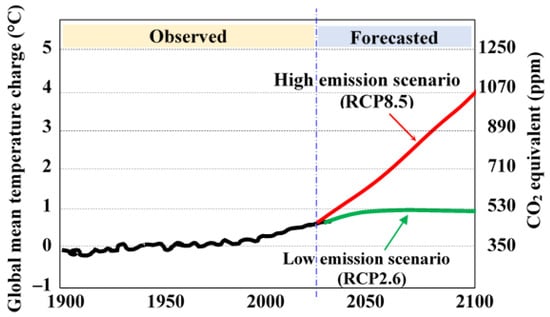
Figure 2.
Global average temperature.
The obvious solution to this problem is to return to exploiting solar and wind energy, which are renewable, inexhaustible, ecological, and abundant; see Figure 3 and Figure 4 [9,10].
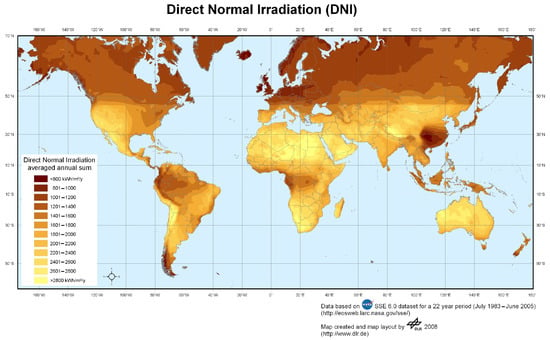
Figure 3.
Global annual irradiation. https://www.solarpaces.org/csp-technologies/csp-potential-solar-thermal-energy-by-member-nation/ (accessed on 16 May 2023).
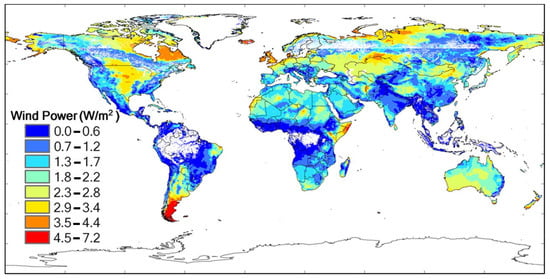
Figure 4.
Global wind power density. https://www.pnas.org/doi/full/10.1073/pnas.0904101106 (accessed on 16 May 2023).
Indeed, forecasts have shown that energy needs will reach 55 PWh/year by 2050. The consumption of electricity will increase by 140% with respect to the current consumption, and due to increases in the price of other resources, solar and wind turbine energy will become the main renewable energy sources; see Figure 5.
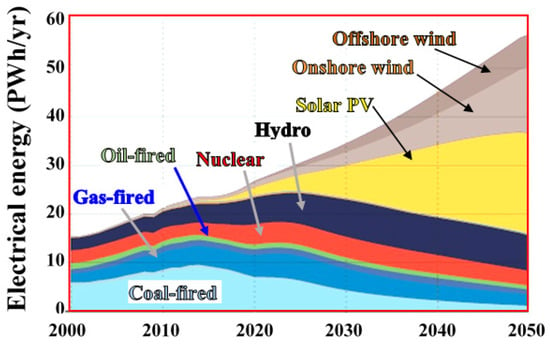
Figure 5.
World electricity generation by source. https://renewablesnow.com/news/renewables-produce-85-of-global-power-nearly-50-of-energy-in-2050-582235/ (accessed on 16 May 2023).
The report on energy by the European Commission says that, from now to the year 2050, photovoltaic (PV) stations, onshore wind turbines, and hydroelectric and offshore wind turbines will produce around 85% of the world’s electricity, which will constitute approximately 50% of the world’s total energy. Furthermore, due to the high demand for energy, these resources will continuously progress and develop. For instance, the total capacity of renewable energy has increased by 11%, reaching approximately 3146 GW by the end of 2021. Among all the renewable energy resources, solar energy and wind turbine energy account for approximately 90% of all renewable resources. This percentage applies to the worldwide energy consumption during the last ten years, as shown in Figure 6 [11,12].
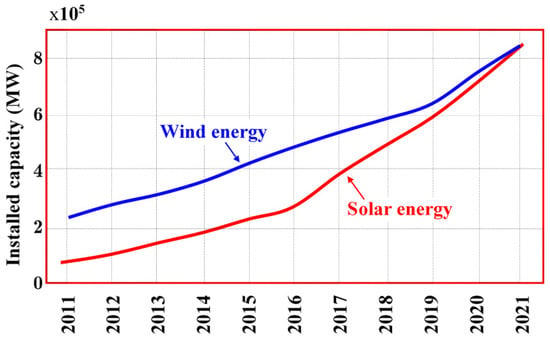
Figure 6.
Trends in the capacity of installed wind and solar systems [11].
Many countries have invested in renewable energy; for example, the United States allocated USD 280 million to research and development of solar energy and USD 110 million to research and development of wind energy in their budget for the year 2021 [13]. The World Bank approved USD 165 million for India to build rooftop solar systems by June 2022. The goal of the project is to reduce greenhouse gas emissions by 13.9 million tons (https://www.worldbank.org (accessed on 16 May 2023)). In addition, in 2023, the UN will invest approximately USD 640 million into energy access and clean energy transitions in underdeveloped countries (https://www.un.org (accessed on 16 May 2023)).
The performance of solar photovoltaic systems (SPVSs) and wind energy conversion systems (WECSs) is mainly based on environmental factors, i.e., irradiation/temperature and wind speed, respectively. The electric production of SPVSs and WECSs cannot be accurately predicted because the availability of these quantities is very intermittent and irregular in nature, and therefore, it is not possible to use one of them to continuously generate electrical power. Therefore, a hybrid renewable energy system (HRES) with a combination of different types of renewable energies such as solar, wind, and hydro would be a good solution for continuous power generation. For example, Figure 7 shows monthly weather data recorded during the year 2019, as well as daily data recorded on 10 June 2020, by the National Renewable Energy Laboratory (NREL) in the United States [14]. This shows that HRESs have the ability to minimise the power fluctuation generated by a single source. In addition, a properly designed wind–solar hybrid system can provide satisfactory grid power performance [15].
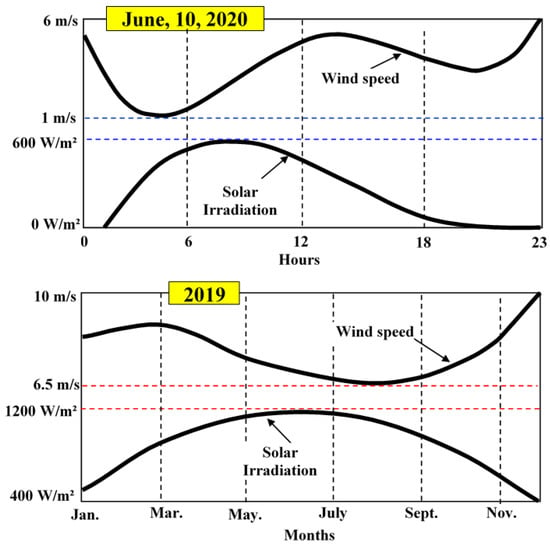
Figure 7.
Weather data by National Renewable Energy Laboratory (NREL), USA [14].
HRESs have been studied by various researchers [16,17,18,19]. Due to their complementary characteristics, mature technologies, and availability in most areas, hybrid solar and wind energy systems have been found to be more reliable and commercially viable [10]. In addition, with the growing demand for energy from end-users, particularly those in isolated areas, standalone hybrid systems based on solar and wind power have become one of the most popular choices in such situations.
Several HRES projects have been carried out around the world, reflecting the global trend towards renewable energy, in particular PV–wind. Examples of HRES projects include the following: [20,21,22].
- United States HRES projects: Wheatridge (300 MW of WT, 50 MW of PV and 30 MW of battery storage), NextEra (250 MW of WT, 250 MW of PV, and 200 MW of battery storage), and Enel (497 MW of WT and 450 MW of PV);
- Australia HRES project: Flinders Shire (43.2 MW of WT, 15 MW of PV, and 2 MW of battery storage);
- Denmark HRES project: Fjord (43.2 MW of WT, 15 MW of PV, and 2 MW of battery storage);
- Spain HRES project: Vestas (3.3 MW of WT and PV).
This paper is organised as follows: Section 2 presents the review protocol used in this paper and shows how the systematic search was conducted. Section 3 provides mathematical models of solar cells and wind turbines. Section 4 gives the different topologies of solar and wind conversion lines. Section 5 deals with the control strategies applied to solar and wind systems. Section 6 is devoted to the study of PV and wind hybrid systems, with a focus on hybrid system configurations, and optimal sizing techniques are given. In Section 7, different strategies for energy management are discussed. In Section 9, we conclude with a discussion.
2. Review Protocol
The hybridisation of renewable sources (especially PV–wind) is a relatively new research field but has reached a very advanced technological level. In this paper, a systematic search of the scientific literature was performed to cover all aspects and trends of research on PV–wind hybrid systems. The main sources of information for providing an overview of these systems were well-known journal databases. The databases used were Web of Science, Science Direct, Springer, Wiley Online Library Journals and eBooks, IEEE-Xplore, Taylor and Francis, INSPEC, ACM Digital Library, and some specialised MDPI journals, among others. As the research field of PV–wind hybrid systems is vast, thousands of scientific papers have been published in the last twenty years. Some criteria were adopted for the initial search using specific keywords (such as PV–wind hybrid systems and PV–wind energy management) in order to filter the preliminary results. These criteria were as follows:
- Articles must be published only in English, in journals of recognised reputations, or in specialised conferences on PV and wind hybrid systems;
- Redundant papers should be avoided, especially those by the same authors;
- Papers must address the issues hybridisation, energy management, or grid integration (smart grid).
The search resulted in a total of 250 papers, covering many different issues related to PV–wind hybrid systems. After careful reading and analysis to select the most relevant papers, this number was reduced to about 170 papers. Then, the papers were classified into four axes, according to the main problem addressed:
- PV–wind hybrid system modelling;
- PV–wind hybrid system topologies;
- PV–wind hybrid systems control;
- PV–wind hybrid systems energy management.
Each axis is addressed in a specific section of this paper.
3. Constitution, Characteristics, and Modelling of Wind and PV Systems
3.1. Photovoltaic System
In general, the exploitation of solar energy is performed via two techniques: the first concerns the thermal process and the second concerns the photovoltaic process [23], Figure 8.
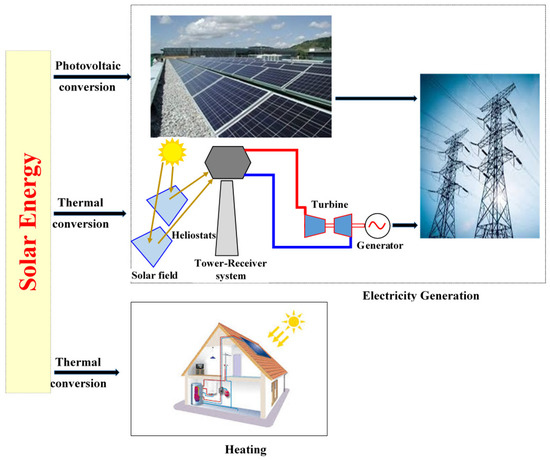
Figure 8.
Solar energy conversion types.
A photovoltaic cell is an electronic component that converts light energy directly into electricity via photosynthesis, a photo-electrical process. In general, a solar cell is similar to a diode with a silicon PN junction. It produces a low voltage when in an open circuit. The electrical characteristics, such the voltage, the current, and the resistance, depend on solar irradiation.
By connecting several cells in series or/and in parallel, we obtain a module. Connected modules gives rise to a panel. A photovoltaic station contains several panels connected in series or/and in parallel. The production of solar cells is based on different technologies including the following [24]:
- Mono-crystalline silicon [25] has an efficiency around 26% and requires low maintenance, but its cost of production is very high.
- Poly-crystalline silicon [26] has an efficiency around 22% but its cost of production is very high.
- Thin film [27] has an efficiency of 23% and a low cost of production. However, its drawback is its fragility.
- High concentrating PV (HCPV) [28] has an efficiency around 28% and a low cost of production but it requires a high level of maintenance.
3.2. Mathematical Model of a Solar Cell [24]
Several studies have been published on solar cell models. Well-known models include the single-diode model (SDM), the double-diode model (DDM), and the triple-diode model (TDM), Figure 9, Figure 10 and Figure 11.
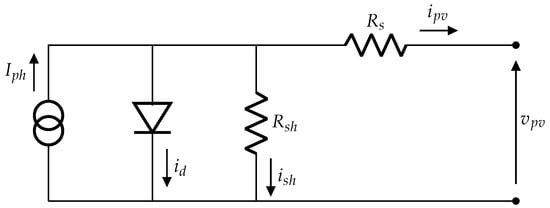
Figure 9.
Model of a photovoltaic cell with one diode.
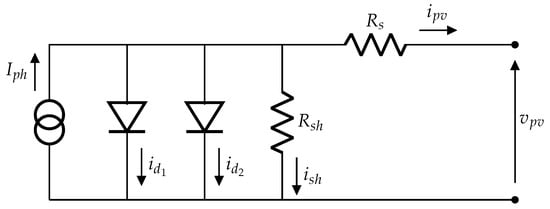
Figure 10.
Model of a photovoltaic cell with two diodes.

Figure 11.
Model of a photovoltaic cell with three diodes.
The three models shown in Figure 9, Figure 10 and Figure 11 can be distinguished based on their accuracy, their performances, and the applications for which they are intended. For instance, the SD model is more appropriate for control applications but not for a performance analysis of the materials used in their production, which would be better performed using the TD model. However, the TDM is more accurate since it takes into account the majority of cell phenomena [29]. In [24], the authors presented various technologies and solar cell models by listing the pros and cons of each, as well as the parameter estimation methods for a solar cell.
The single-diode model is the most widely used for modelling and controlling photovoltaic conversion chains due its simplicity, acceptable accuracy, and short calculation time. This model can be given by the following equation:
where is a current with reverse saturation, K is the Boltzmann coefficient, T is the temperature, e is the electron elementary, n is the ideality factor, is the series resistance, is the shunt resistor resistance, Iph is the photonic current, is the PV voltage, and is the PV current. In general, the PV generator is made up of parallel cells and serial cells. The branch is commonly removed because the value of Rsh is high. In this case, we can write the following equation:
The PV power depends strongly on the irradiation level; therefore, it depends on the meteorological conditions. However, an increase in temperature causes the panel performance to deteriorate (Figure 12).
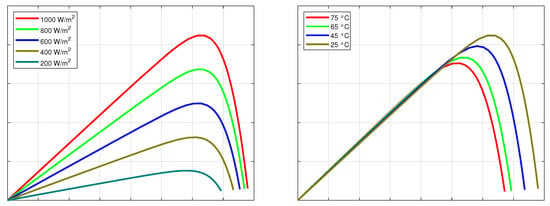
Figure 12.
V-P characteristics: the influences of irradiation and temperature.
In general, some photovoltaic panel parameters are given by markers such as the open-circuit voltage (), the short-circuit current (), the optimal voltage (), the optimal current (), and the maximal power () (Figure 13).
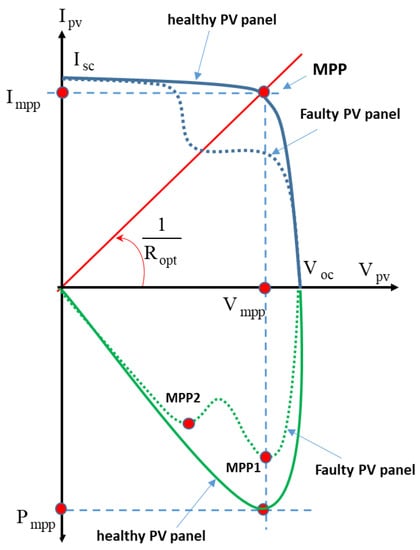
Figure 13.
The V-I and V-P characteristics of PV panel in healthy and faulty conditions.
Photovoltaic panels are usually exposed to extreme working conditions (high temperatures, dust, pollution, construction defects, external faults, partial shading, etc.; Figure 13), which leads to their performance degrading and their lifespans decreasing. In [30,31,32,33,34,35,36], the authors presented a comprehensive study on the most common defects in PV systems, their causes, and their effects on performance. Additionally, they presented different methods of fault diagnosis.
3.3. Mathematical Model of Wind Turbines
There exists two types of wind turbines: those rotating around a horizontal axle, that is, horizontal wind turbines (HWTs), which can be installed in an urban area, and those rotating around a vertical axle, that is, vertical wind turbines (VWTs), which can be installed onshore or offshore [37,38,39,40].
The efficiency of an HWT is clearly better than that of a VWT, and this is due to the form of their vanes which are similar to the wings of an airplane and can be used in the presence of strong wind. Unfortunately, they necessitate a strong tower to support the weight of the nacelle and their cost is very high. In contrast, VWTs are less expensive and they broadcast less noisy sound compared with HWTs [41].
Aerodynamic models are based on fluid mechanics and Newton’s second law. The kinetic energy from wind that can be recovered by a turbine is expressed as the aerodynamic power:
where
where S is the surface swept by the propellers, R is the length of the blade, is the density of the area, v is the wind speed, and is the power coefficient. This coefficient depends on the shape of the propellers, and the type and dimensions of the turbine . The parameters and are, respectively, the tip speed ratio and the pitch angle of the turbine [42].
Figure 14 represents the variation in as a function of for different values of . It is established that has a maximum value for each value of angle which is indicated by an ’*’. Figure 15 represents the variation in aerodynamic power of the turbine for different values of the turbine speed but is kept equal to zero.
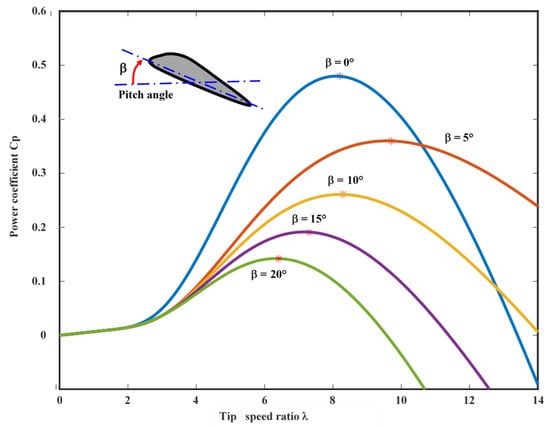
Figure 14.
Power coefficient versus specific speed and pitch angle [42].
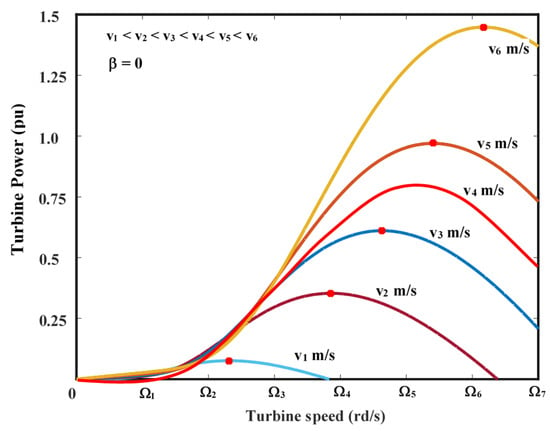
Figure 15.
Aerodynamic power of the wind turbine [42].
The theoretical maximum value of the coefficient is according to the Betz limit. Unfortunately, this value is never reached because the calculation of this value is performed under a number of assumptions; for example, we consider that the thermal energy is negligible and that the density of the fluid remains constant. Figure 16 represents the of the different existing wind turbines.
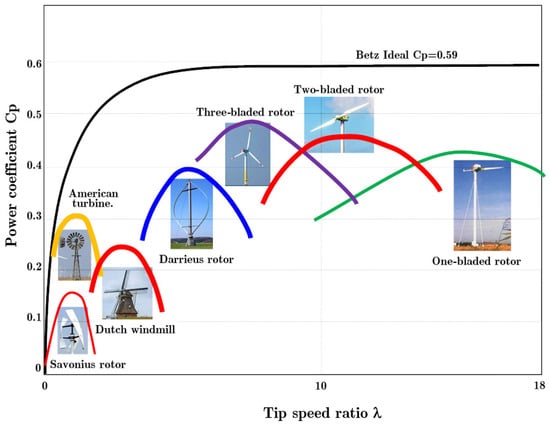
Figure 16.
Power coefficient of the different types of wind turbines [42].
To produce electricity, the turbine is coupled to the shaft of a generator. In general, the rotational speed of the turbine is small; this requires the insertion of a speed gearbox between the turbine and the generator. See Figure 17.
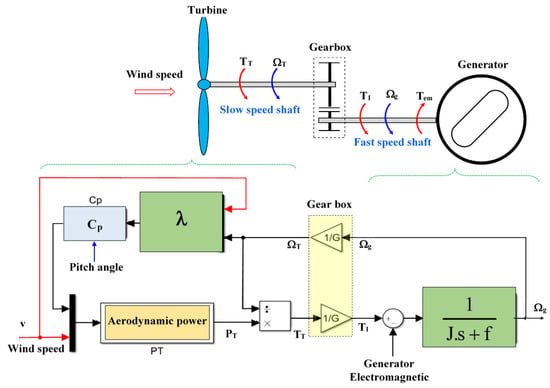
Figure 17.
Functional block diagram of wind turbine system.
However, this gearbox is eliminated in some particular cases where the generators have a high number of poles. The advantage of this solution is the reduction in the weight of the wind turbine.
3.4. Wind Turbine Generator
In wind energy systems, the choice of generator is very important because it depends on several criteria, for example, the nature of the power (AC or DC), the power-to-mass ratio, the possibility of operating at variable speeds, the number of poles, the price, etc. There are various types of generators such as DC generators, induction generators, and synchronous generators. Although the use of DC generators has stopped for a long time, another variant has replaced it (brushless DC generators). The main generators used in wind systems are as follows [37,38,39,40,41]:
- Synchronous generator: This generator has a low cost of construction, and a rugged and very simple design. However, the lack of excitation winding makes operations in the generator mode very difficult. It requires reactive power for its magnetisation. This power is taken from the electrical grid, which affects the power factor. Additionally, converter costs are high, since a converter must be rated at full system power.
- Doubly fed induction generator (DFIG): The accessibility of the rotor allows this type of generator to control the stator power. The rotor power is about 25% of the total power of the DFIG. This advantage allows for the use of a low-power converter and, therefore, less losses. Additionally, it is easy to control the power factor. However, the problems lie in the brush–ring system, the control of the converters being a bit complex, the heavy weight, the expensive costs, and the requirement of a lot of maintenance.
- Wound field synchronous generator: This generator can be driven directly by the turbine, which considerably reduces the weight of the turbine. Furthermore, the reactive power can be controlled by the excitation. However, the grid connection requires synchronisation.
- Permanent magnet synchronous generator: For this generator, the gearbox can be eliminated, which reduces the turbine weight. Moreover, no rotor losses occur due to the absence of field windings. This generator also has a very high torque and a high power-to-mass ratio. On the other hand, its price is a bit high, and heating of the machine risks demagnetising the permanent magnets.
4. PV and Wind System Topologies
In this section, we review the different existing topologies of PV and wind conversion systems.
4.1. Power Converters Used in PV and Wind Systems
The technological evolution of power electronics has considerably boosted the use of renewable energies by improving their quality and efficiency. Several authors have discussed the different topologies of converters used in photovoltaic and wind systems and have classified them into the following four large families [43,44,45,46,47,48,49]:
- AC–DC converters;
- DC–DC converters;
- DC–AC converters;
- AC–AC converters.
4.2. Topologies of PV Systems
Figure 18, Figure 19, Figure 20 and Figure 21 present some well-known PV system topologies. Although other topologies exist, such as those given in [50,51,52,53], all these topologies depend on the level of power, the voltages, the type of associated converters, and whether the system is connected to the grid.

Figure 18.
Topology based on one converter [50,51,52,53].

Figure 19.
Topology based on two converters [50,51,52,53].
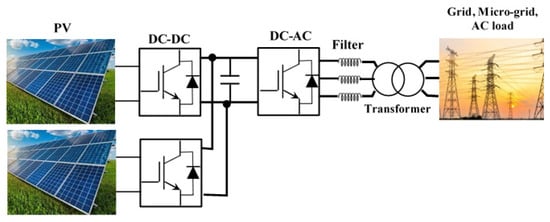
Figure 20.
Topology based on parallel configuration [50,51,52,53].
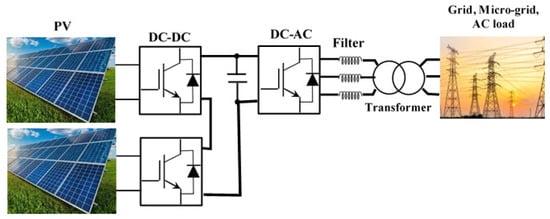
Figure 21.
Topology based on series configuration [50,51,52,53].
The use of several converters makes it possible to reduce their dimensioning because the power will be divided by the number of converters used. Additionally, in the event of a fault in one of the converters, continuity of service is ensured even with less power available. The issue then is the complexity of controlling a large number of converters.
4.3. Wind Turbine Energy Conversion Systems
Several publications can be found in the specialised literature and deal with different topologies. These topologies are indexed with respect to the type of aero-generator used or with respect to their converters. The most interesting publications are those that give the state of the art concerning all possible topologies [37,54,55,56,57].
In the topologies presented in Figure 22 and Figure 23, the generators are connected to the grid via a back-to-back converter. The side generator converter provides two functions: control of the active power generated by IG and ensuring reactive power to excite the induction generator. This is well suited for variable speed operations because it passes through direct current. The grid-side converter ensures that power is injected into the grid at an acceptable power factor. The problem with this topology is that all of the power need to go through two converters, which requires an oversized converter and, therefore, a high cost [37,54,55,56,57].

Figure 22.
Topology based on induction generator.

Figure 23.
Topology based on synchronous generator with two converters.
In the topology presented in Figure 24, the stator of the doubly fed induction generator is connected directly to the grid, while the rotor is connected to the grid via a back-to-back converter. The converter on the rotor side provides control of the active and reactive stator power generated. This configuration is well suited for variable speed operations because it generates a constant frequency stator voltage by controlling the rotor frequency. The grid-side converter is used for excitation of the double generator supplied by the rotor without affecting the power factor of the installation. The first advantage of this topology is that the power factor can be kept uniform. The second advantage is that the power that passes through the back-to-back converter represents 25% of the total power generated; therefore, it is a low-power converter, i.e., of low cost [37,54,55,56,57].
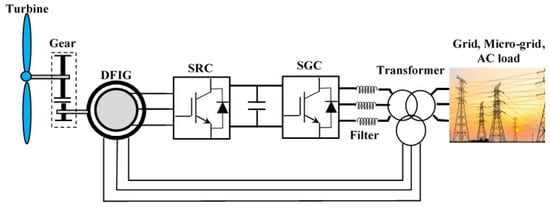
Figure 24.
Topology based on doubly fed induction generator.
In the topology presented in Figure 25, the converter on the generator side in Figure 22 and Figure 23 is replaced by a diode rectifier and a DC–DC converter. Therefore, we have the same problems as having more converters [37,54,55,56,57].

Figure 25.
Topology based on synchronous generator with three converters.
5. PV and Wind Turbine Control Strategies
Figure 26 presents a typical control block diagram used for PV and wind energy conversion systems. Renewable sources are connected to the side renewable source converter (SRenSC) [58,59,60].
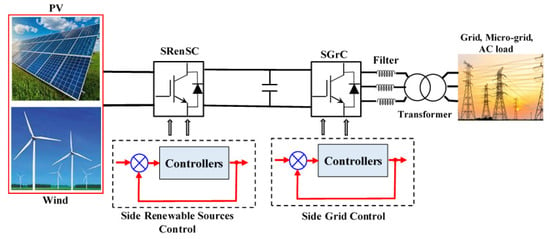
Figure 26.
Typical topology used in wind and PV systems.
5.1. Photovoltaic System Control
Figure 27 presents the most popular control block diagram for a solar energy conversion line. The photovoltaic generator (GPV) is connected to a DC/DC converter in order to track the maximal power produced by the GPV whilst adapting its voltage to that of the network (or the load). In general, the types of used controllers are PI controllers, sliding mode controllers, heuristic-type controller, etc. [58,59,60].

Figure 27.
Photovoltaic controllers: (a) with one loop and (b) with two loops.
Photovoltaic system maximum power point tracking (MPPT): Photovoltaic energy is one of the main renewable sources. The power produced varies considerably depending on the variations in the irradiation, the type of cells, and the ambient temperatures. To date, the efficiency of the panels remains quite low, not exceeding 28%. This is one of the major challenges that researchers are trying to overcome. In the meantime, other researchers are interested in extracting the maximum power available from photovoltaic panels. As a result, several techniques have been developed for MPPT to improve the energy efficiency of photovoltaic systems (Figure 28). In References [30,31,32,33], the authors have outlined all existing MPPT techniques in the literature. They have been classified according to their complexity, stability, real-time implementation, accuracy, and algorithms used. Thus, conventional, intelligent, optimisation, and hybrid techniques have been created. The authors have shown that, compared with conventional methods, hybrid techniques are very efficient for photovoltaic systems that are subject to parametric variations and defects. However, their implementation is very complicated and expensive.
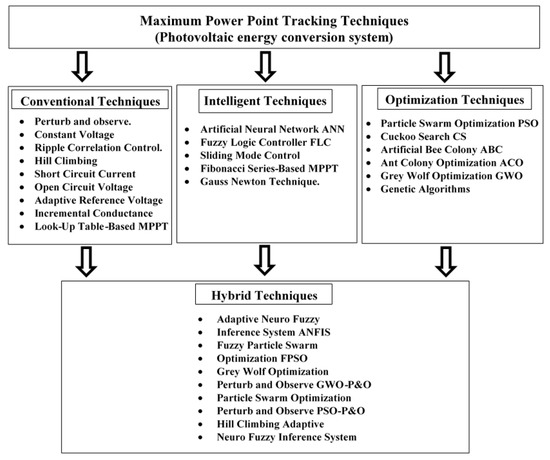
Figure 28.
Photovoltaic MPPT classification [30,31,32,33].
5.2. Wind Turbine System Control
Figure 29 presents a popular control block diagram used for the wind turbine power conversion line.
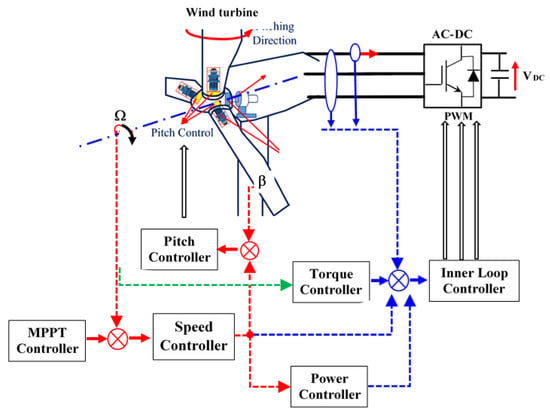
Figure 29.
Wind turbine control [61,62,63,64].
It is worth noting that Figure 30 shows the operating zone pertaining to the control loops presented in Figure 29. Each control takes place separately depending on the rotational speed, the wind speed, and the generated power. In general, the switching between each control is performed by some activation function.
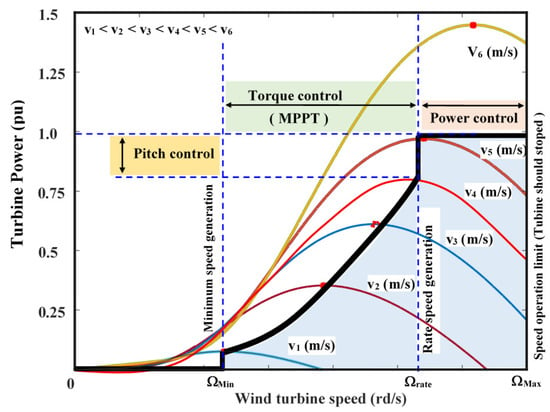
Figure 30.
Wind turbine control modes.
Wind turbine MPPT controllers: The electrical power generated by the wind turbine depends on the wind speed, and the type and dimension of the turbine. The efficiency of the wind is better that of than PV systems, about 59%. To improve the efficiency of the wind systems, many researchers have been worked toward developing MPPT controllers based on many strategies. As a result, several methods have been proposed for maximum power point tracking to improve the energy efficiency of wind systems (Figure 31).
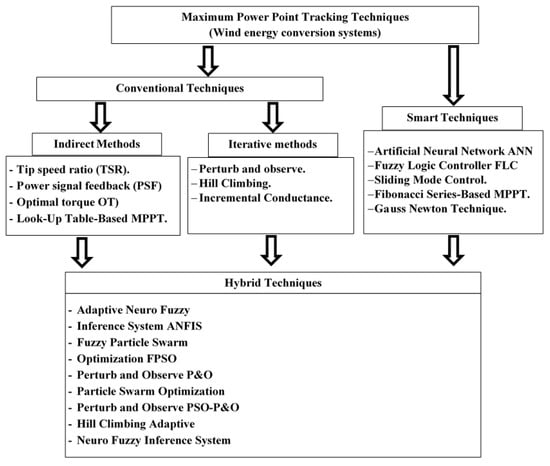
Figure 31.
Wind turbine MPPT classification [43,44,45].
In References [43,44,45], the authors have outlined all existing MPPT techniques in the literature. These techniques have been classified into conventional methods; smart techniques, for instance, artificial intelligence (AI); optimisation techniques; and hybrid techniques. In PVs, hybrid methods are very efficient and robust. However, their implementation is not easy.
However, on the generator side, control of the converter includes several control loops, especially when pitch control is used in order to adjust the angle of the vanes when the wind turbine is working at a constant speed (Figure 32) [61,62,63,64]. In addition, a second control loop is dedicated to maximum power tracking (torque control).
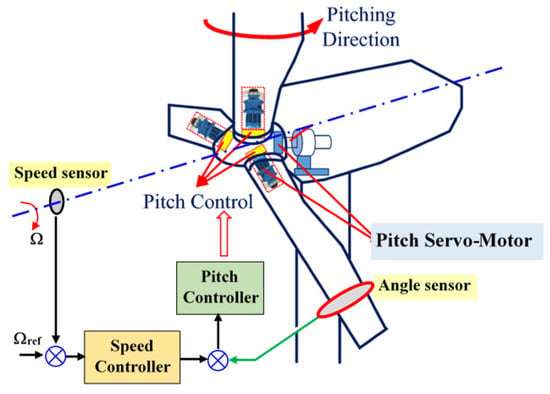
Figure 32.
Pitch control scheme.
Figure 29 presents an example of MPPT based on speed control by means of a PI controller, among others. However, there exist other applications with the use of more advanced control methods. Two inner loops are used in the control of a direct current and its orthogonal (or the active and reactive powers). In general, the main strategy used in the control of an AC generator is based on vector control techniques; it is the simplest method to obtain a linear model and, as a consequence, to decouple active power from reactive power [61,62,63,64].
5.3. Grid-Side Control
On the network side, the used converter is in fact an inverter. Controlling the inverter follows three objectives. The first one is the stabilisation of the voltage of the DC bus. The second objective is the synchronisation of the system with the network via a phase-locked loop (PLL). The third objective is control of the transfer of active power to the network (or the load) with a power efficiency that is not far from being uniform (see Figure 33). The last two objectives are implemented in two loops in series with various types of controllers (see Figure 34), from the well known PI to sophisticated controllers based on non-linear control or AI [58,59,60].
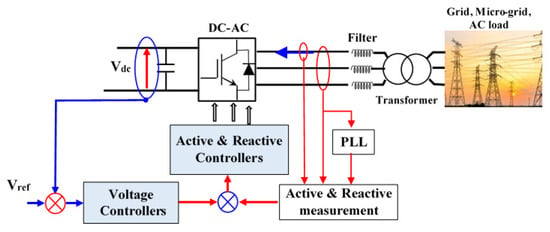
Figure 33.
Grid active and reactive power control.

Figure 34.
Grid current control.
6. Hybrid Renewable Energy Sources (HRES)
In the 1960s and 1970s, the first energy management system, known as the Energy Control Centre (ECC), emerged. It was followed by the Supervisory Control And Data Acquisition (SCADA) system. These systems are used to track and collect data in networks and industrial production lines. In the 1980s, the SCADA became the preferred real-time surveillance controller due to its computing capacity. Several tasks are included in this system such as demand-side management (DSM), load control (LC), and distribution management (DM).
Due to the intermittent behaviour of the wind and the sun, it is almost impossible to ensure a continuous supply of electrical energy from these resources without combined use with other systems such as batteries. Another alternative is the hybridisation of both resources. This solution has many advantages, such as an increase in the efficiency and reliability of the whole system [16,17,18,19]. Figure 35 shows different possible combinations of HRESs.
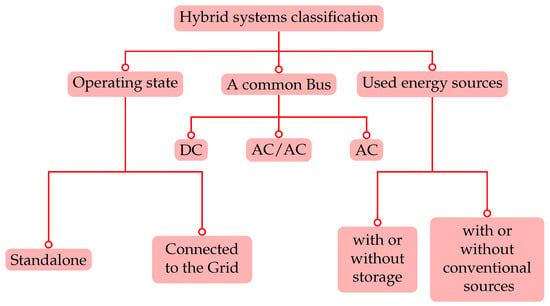
Figure 35.
Various types of HRESs.
6.1. Hybrid System Configurations
In general, three configurations are considered:
- Common DC bus: Figure 36 presents a hybrid system with a DC bus. The output of the wind turbine generator is connected to the DC bus by means of an AC/DC converter, while the output of the photovoltaic generator is connected to the DC bus through a DC/DC converter. The energy storage system is connected to the DC bus by means of a bi-directional converter. This system can simultaneously supply AC loads, as well as DC loads. A DC/AC converter is necessary when AC loads have to be supplied. In this topology, one can incorporate other renewable resources using adequate power converters. This configuration gives rise to several operational advantages such as its simplicity, particularly as it removes the synchronisation problems. The main drawback of this solution is the energy losses in the different converters. Especially for the wind turbine line, this represents around 10% of the total energy of the wind turbine [16,17,18,19].
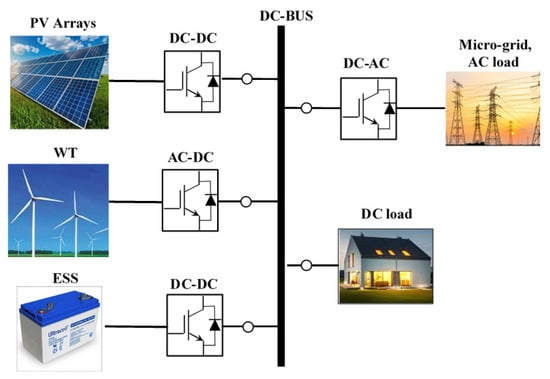 Figure 36. Configuration of the hybrid system with DC bus.
Figure 36. Configuration of the hybrid system with DC bus. - A common AC bus: Figure 37 presents a hybrid system with a common AC bus, where the PV is coupled to the AC bus by means of a DC/AC converter and the wind turbine is coupled to the AC bus through an AC/AC converter. The storage system is connected to a bi-directional DC/AC converter. In this configuration, the AC/DC converter unavoidably supplies the DC loads, and other renewable resources can be connected. In this topology, all the sources are connected to the AC bus through their own converters, this is an advantage that allows the reliability of the system to be improved (even if one of the sources is disconnected). However, the need for synchronisation is the major drawback of this configuration [16,17,18,19].
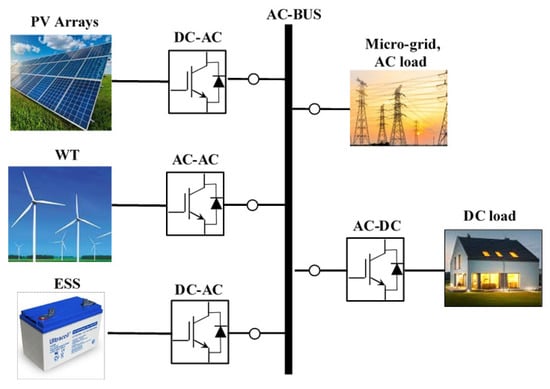 Figure 37. Configuration of the hybrid system with AC bus.
Figure 37. Configuration of the hybrid system with AC bus. - With two buses: Figure 38 presents a hybrid system with two buses, that is, an AC bus and a DC bus. In this case, a source with an alternative current is connected to an AC bus, while those with a DC current are connected to the DC bus. The main advantage of this configuration is the improved global efficiency of the system through a reduction in the number of converters. This configuration is very popular due to its flexibility in combining power resources and loads [16,17,18,19].
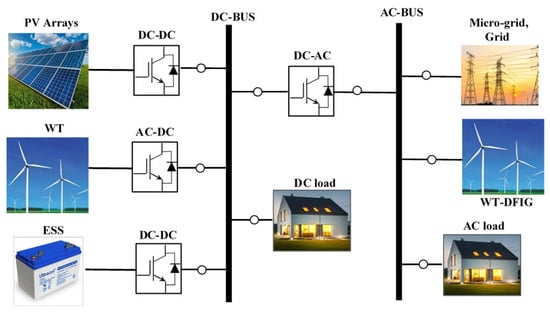 Figure 38. Configuration of the hybrid system with DC and AC buses.
Figure 38. Configuration of the hybrid system with DC and AC buses.
6.2. Storage Process
The storage system integration in the hybrid architectures allow for the intermittent effect of the renewable resources to be reduced. These storage systems contribute in other ways too, such as
- Controlling the voltage and current peak values;
- Avoiding voltage fluctuations;
- Reducing harmonics;
- Stabilising the frequency;
- Shedding the load and stabilising the transient behaviour.
Batteries and super-capacitors are the most commonly used storage systems. The battery design depends on a number of constraints, such as
- The voltage and the current;
- The ratio and the duration of the charge and discharge;
- The operating temperature during the charging and discharging phases;
- The number of charging cycles;
- The cost, size, and weight.
The batteries available nowadays are based on, for instance, lead–acid, nickel–cadmium, lithium ions, and lithium-ion polymers [16,17,18,19].
A hybrid storage system (batteries or super-capacitors) is used in order to achieve a low installation cost. These storage systems allow for additional reductions in the high-frequency effect. The hybrid storage system can be connected directly to the DC bus or through bi-directional converters (Figure 39).
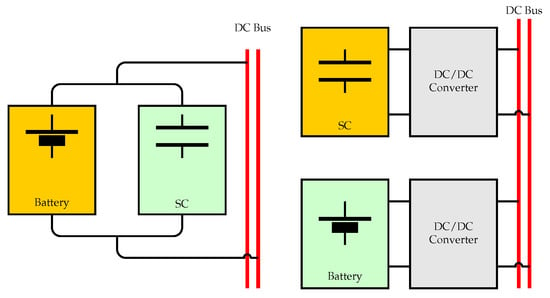
Figure 39.
Passive and active storage systems.
Several results can be found in the specialised literature dealing with hybrid systems combining PV and wind turbines. These results can be divided in two categories: those dealing with systems without storage [65,66,67,68,69,70,71,72,73,74,75,76] and those dealing with systems integrating a storage system [77,78,79,80,81,82,83,84,85,86,87,88,89,90,91].
6.3. Design and Optimisation of Hybrid PV–Wind Systems
The main objective in using optimal sizing techniques in hybrid systems is to obtain the best global performance and to comply with network constraints. It is necessary to implement an optimisation algorithm to find a solution that allows for low kWh production costs. Several optimisation algorithms exist, such as the genetic algorithm [92,93,94,95,96,97,98,99,100,101] or particle swarm optimisation (PSO) [91,102,103,104,105,106,107,108,109,110,111].
7. Hybrid System Management
In hybrid systems with multiple renewable sources, the management system comprises two stages. The first stage involves the energy management system (EMS) and the second involves the power management system (PMS). Figure 40 illustrates these two stages [112].
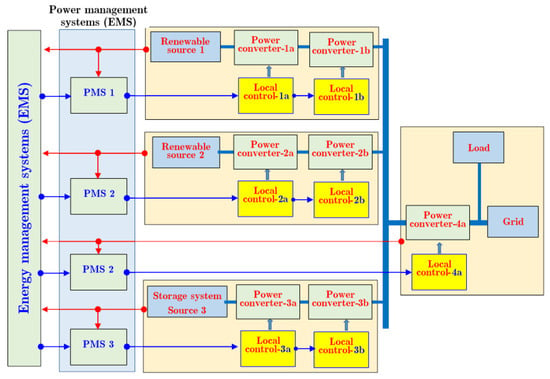
Figure 40.
Hierarchical structure of energy and power management in hybrid systems.
7.1. Energy Management Systems (EMSs)
Energy management systems are also used for supervisory control and data acquisition. They comprise several tasks such as demand system management (DSM), load control (LC), and distribution management (DM). Hereafter, we give some EMS techniques reported in the literature [113,114,115,116,117,118,119,120,121,122,123] and based mainly on the following:
- Mixed integer linear or nonlinear programming, dynamic programming (DP), and rule-based methods;
- Metaheuristics (GA, PSO, etc.);
- Artificial intelligence, fuzzy logic, neural networks, etc.;
- Model predictive control (MPC) methods.
Hybrid power systems (HPSs) based on renewable energy sources (RESs) are becoming more popular as a sustainable solution for obtaining clean energy, especially for powering remote sites that are difficult to connect to public networks. To improve the performance of these systems, various renewable energy conversion systems have been combined, and the development of smart distribution strategies has become a necessity. Energy management is crucial for achieving smart grid operations, reliability, and efficiency, and the aim of energy management strategies is to generate goods and services with minimal costs and the least environmental impacts. Accordingly, one definition of an energy management strategy is as follows: “The prudent and effective use of energy to maximise profits (minimise costs) and strengthen competitive positions” [124]. This approach aims to achieve economic objectives while minimising the impact on the environment. Due to the intermittent nature of RES and the random demand of the load, different management and supervision strategies for this kind of HPS have been proposed in the literature [125]. The main issue is finding an adequate approach for controlling the converters associated with each source to attain fixed objectives, and the power converters connected to these renewable sources make it possible to maximise the generated power or to adapt production according to the need. Two main categories of management strategies for HPSs are rule-based (RB) and optimisation-based (OB) strategies, as shown in Figure 41.
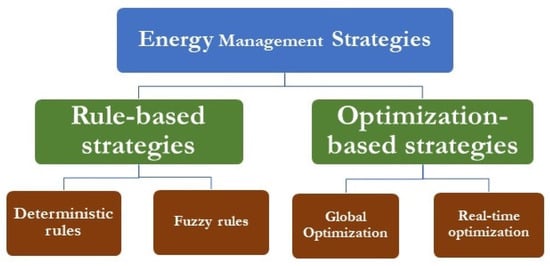
Figure 41.
Proposed EMS classification.
Rule-based EMSs are based on a set of predefined rules that are determined by human expertise and analyses of the system’s behaviour. Rule-based EMSs are simple to implement and effective in real-time applications, but they may not always provide the optimal solution. There are two types of rule-based EMSs: deterministic and fuzzy. Deterministic rules are extracted based on expertise and objectives, while fuzzy rules are managed with the help of fuzzy logic. Fuzzy rules are an improvement over deterministic rules because they are more robust against inaccuracies in measurements and can adapt better. Optimisation-based EMSs utilise optimisation methods to minimise cost functions while meeting dynamic constraints. The objective is to find the best way to distribute and consume energy to meet load demand. There are two types of optimisation control: global optimisation and real-time optimisation. Global optimisation reduces cost functions based on future and past dynamic requirements, while real-time optimisation continuously evaluates and modifies operating conditions for maximum economic efficiency. RB and OB strategies have multiple algorithms, including classical and artificial intelligence methods, to enhance EMSs for hybrid power systems. The literature presents various EMSs that aim to address challenges in hybrid power systems. These include both traditional and artificial intelligence-based methods, as illustrated in Figure 42.

Figure 42.
Classification of EMSs.
7.1.1. Energy Management Based on Classical Methods
In this section, we discuss various energy management methods for microgrids, with a focus on classical approaches such as iterative algorithms, linear programming, mixed-integer linear programming (MILP) and model predictive control (MPC). These methods have been applied to optimise the size and operation of hybrid energy systems, including standalone systems and those connected to the grid.
Iterative algorithms are commonly used for sizing optimisation of isolated systems with single objective optimisation functions, while linear programming has been used to minimise computational time, energy costs, CO2 emissions, and increased battery life. MILP approaches have been used to model EMSs that minimise operation cost and favour self-consumption based on forecast data, while MPC-based EMSs are designed to optimise the use of renewable resources while maintaining comfortable conditions.
Examples of the application of these methods include the following: an iterative algorithm used for sizing optimisation of a residential microgrid [126]; a linear programming-based EMS for a hybrid system comprising PV and wind energy, fuel cells (FCs), and batteries [127]; and three suggested EMSs for a standalone HPS comprising PV and wind energy, and FCs, where the battery efficiency is assessed using an available control algorithm software. In addition, a hybrid microgrid consisting of two RESs (WT and PV generators), a battery energy storage system (BESS), and a variable load was described in [128], and an EMS of a smart home based on comprehensive MILP was introduced in [129,130]. Lastly, an MPC-based EMS to control the power flow of a standalone system based on PV, FCs, and batteries are presented, along with an EMS for a PV–battery microgrid that is also based on MPC [131,132].
7.1.2. Energy Management Based on Artificial Intelligence Methods
This section discusses various studies focused on energy management in hybrid microgrids using artificial intelligence techniques such as fuzzy logic, neural networks, evolutionary computation, and multi-agent systems. The aim of these studies is to optimise the exploitation of energy sources integrated into a microgrid and to make the right decisions for various scenarios that a multi-source system may face during operation; see Figure 43.
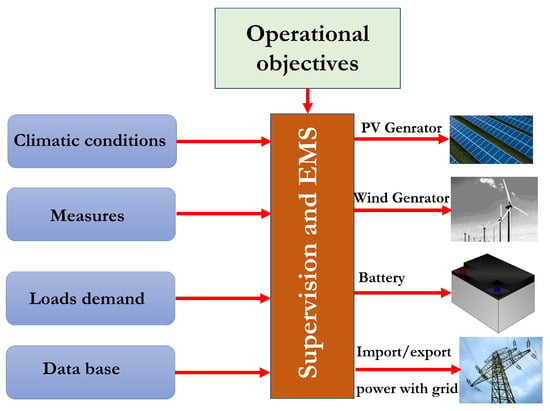
Figure 43.
Energy management system (EMS) configuration.
Fuzzy logic tools are used for efficient energy management in standalone and grid-connected hybrid renewable energy sources. Fuzzy logic controllers have been used to smooth the power profile exchanged between the microgrid and the public grid while keeping the energy storage system (ESS) within safe limits to preserve its lifespan. In addition, fuzzy logic controllers were used to maximise the use of renewable sources, to maintain the appropriate state of charge, and to manage the exchange of energy flows between DC and AC microgrids [133,134,135,136,137].
We also discuss the use of neural networks for power system control. In fact, neural networks have been used for real-time forecasting to predict the availability of renewable resources and loads in advance of implementing proposed strategies [138,139,140]. Furthermore, artificial neural networks based on predictive control approaches have been developed to manage the energy flow in a zero-energy building [141], allowing the EMS to reach maximum exploitation of predicted renewable power sources without using the electrical grid [142,143,144]. The use of evolutionary computation algorithms for global optimisation is also discussed. Genetic algorithms and particle swarm optimisation algorithms have been developed to optimise energy management and the design of hybrid microgrids using wind, PV, tidal, and storage battery systems [145,146].
Finally, the use of multi-agent systems (MASs) in the control of energy management in the grid is an important topic. MASs comprise intelligent agents integrated with several sources and loads working together to optimise the operation of a microgrid power system [147]. The authors in [148] proposed an intelligent EMS based on the MAS technique for a standalone system that powers a racing sail boat using only renewable power sources. Another study [149] used an advanced EMS based on intelligent MAS for a standalone microgrid, which kept the power balance between the generators, loads, and batteries.
Overall, current research highlights the importance of using artificial intelligence techniques for effective energy management in hybrid microgrids, allowing for the optimal use of renewable energy sources and the preservation of energy storage systems. In order to attain its objectives, a multi-source system’s management process must generally adhere to the strategic approach depicted in Figure 42.
7.2. Power Management Systems (PMSs)
Power management systems (PMSs) are used in a hybrid power system (HPS). The PMS is responsible for supervising the overall operation of the hybrid power system and maximising the output of available energy sources such as solar panels, wind turbines, fuel cells, and batteries (Figure 40).
To ensure that energy sources remain sustainable, various power management systems (PMS) have been proposed and documented in the literature. The work in [150,151,152,153,154,155,156,157,158,159,160] all establish different PMS models. The authors of [158], for instance, have developed a computer simulation model that optimises an integrated power generation system that involves photovoltaic modules (PV), wind turbines (WT), PEM fuel cells (FC), electrolysers (ELs), and hydrogen tanks (HTs) for energy storage. That study analysed an integrated PV/WT/FC system under varying conditions such as real measurement values of local solar radiation, wind speed, and three different residential loads.
The hardware of a PMS is designed to handle multiple energy sources and to control the power distribution among conventional and non-conventional power sources to increase reliability and power quality. The PMS also manages the power flow of batteries to fulfill the load demand and adjusts the power distribution among available power sources based on load demand changes. The PMS was designed to work in two stages. The first stage controls all power management and generates references to individual subsystems based on solar radiation, temperature, and load conditions. Based on the command signals, each local controller controls the photovoltaic, wind turbine, fuel cell, and ultra-capacitor. The second stage of the power control strategy involves the PMS coordinating all energy sources, energy storage systems, and loads to ensure continuous operation of the hybrid system. The PMS is also designed to cater to non-availability or less power from non-conventional power sources. In such cases, the PMS utilises batteries and fuel cells to fulfill the load demand. If the batteries and fuel cells are also unable to cater to the load demand, the PMS can, for example, switch on the diesel generator, which recharges the discharged batteries, or connect directly to electricity grids to compensate for the intermittency of the renewable energies. In general, in an HPS structure, photovoltaic and wind energy, and battery sources are used as leading sources. A fuel cell (FC) provides power in the case of non-availability or less power from the photovoltaic, wind energy, and battery sources. The ultra-capacitor (UC) can be utilised in addition to the battery bank as a buffer storage to compensate for the slow dynamic response of the fuel cell/battery bank during transient power demand and to regulate the DC bus voltage. Overall, PMSs play critical roles in maximising and optimising the output of non-conventional energy resources and in ensuring continuous operation of the hybrid power system.
8. PV–Wind Hybrid System Emulators
The analysis and control of industrial PV–wind hybrid systems are complex. This is mainly due to the large size and the power range of such systems. In fact, it is very difficult to study the performance of controllers, as well as power converters and energy management, etc. However, to overcome this issue, emulators have been developed to obtain the static and dynamic characteristics of wind and photovoltaic power conversion systems. These emulators are based on different technologies such as DSP, dSPACE, FPGA, microcontrollers, etc. [139,152,161,162,163,164,165,166,167,168,169,170]. In addition, testing new control techniques, converters, and topologies on a reduced scale becomes very easy and results in time and money savings.
Many high-performance emulators are available on the market, but their prices are too high for laboratories with limited financial resources, especially in emerging economies. Fortunately, some low-cost emulator schemes have been proposed, as shown for example in Figure 44. Indeed, using an Arduino and a few electronic components (sensors, opto-isolators, power switches, etc.), it is easy to build a low-cost real-time wind turbine emulator.
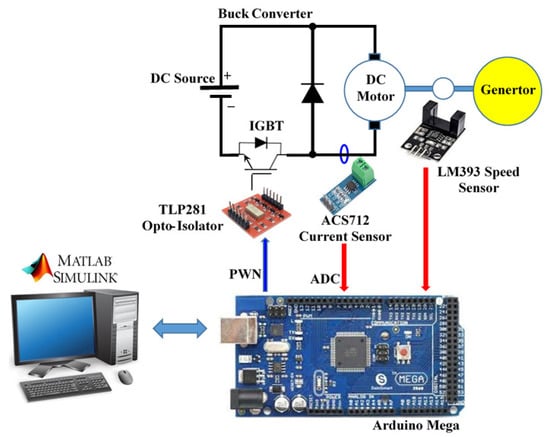
Figure 44.
Hardware for low-cost wind turbine emulator scheme based on Arduino.
Additionally, it is easy to build a control scheme of the wind turbine by using Matlab/Simulink and uploading the Arduino package, as shown in Figure 45.
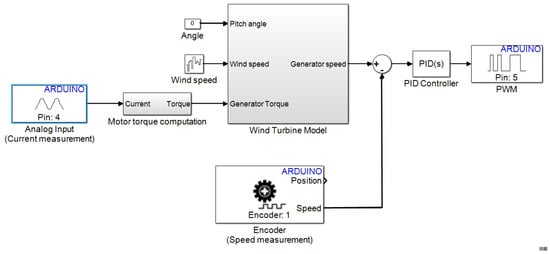
Figure 45.
Wind turbine emulator control scheme based on Arduino package for Matlab/Simulink.
9. Discussion
Although power management techniques improve the efficiency of a whole system in terms of energy distribution, they present some limitations, such as power fluctuation between the microgrid and the main network due to the intermittent energy production of renewable resources and the presence of aleatory charges, which threaten the reliability and stability of electrical network. It is then mandatory to reduce these power fluctuations. In most renewable energy stations, the implementation of power management is still in the early stages, which means that the long-term energy viability and capacity of systems are still far from their final states.
Renewable energy stations are expected to be used more than traditional electrical power plants in the future due to their capacity, reliability, repartition, and auxiliary services. Since HRESs, with their large capacities, are connected to the electrical network, it is expected that the integration of large HERSs will become an important research direction in the near future.
It is worth noting that, given the advances in the field of HERS, future research trends will focus on the following challenges:
- The first challenge of PV and wind systems will be the development of new materials to improve the efficiency of such systems. These technological advances will reduce HERS costs significantly. As a consequence, the HERS system will be more cost-effective in the future.
- The second challenge will be the implementation of new algorithms to forecast energy demand and power production to optimise HERS systems and to reduce total operating costs.
- The third challenge will be the cyber security of HERS facilities, as well as their databases, given that all the power plants are, nowadays, interconnected via the Internet.
10. Conclusions
HRESs, especially based on PV–wind systems, are becoming the most obvious solution for decentralised power generation. They are particularly adopted in rural and remote areas and have recently seen huge progression due to the decrease in equipment prices in recent years. For this reason, HRESs will contribute to the development of emerging economies. The contribution of renewable energies to greenhouse gas emission reductions has been shown in this work. In addition, different parts, models, topologies, control, power converters, and optimal sizing of PV and wind systems have been briefly presented. Then, PV–wind system hybridisation and optimal energy management were reviewed in detail. This work gives a condensed but clear overview of the tools used in HRES research.
As the present contribution aimed to give an overview of different research directions for PV–wind hybrid systems, it may serve as a general reference or as a starting point for new researchers in this field. Moreover, it can be used by teachers in lectures on wind and photovoltaic energies, and their hybridisation. The references listed at the end of this document are intended to guide researchers, academics, and those who work in the industry on their topics of interest, including experimental studies.
Author Contributions
Conceptualisation, L.C.-A., S.D., M.O. and D.M.; methodology, L.C.-A., S.D., M.O. and D.M.; formal analysis, L.C.-A., S.D., M.O. and D.M.; investigation, L.C.-A., S.D., M.O. and D.M.; resources, L.C.-A., S.D., M.O. and D.M.; writing—original draft preparation, L.C.-A., S.D., M.O. and D.M.; writing—review and editing, L.C.-A., S.D., M.O. and D.M.; visualisation, L.C.-A., S.D., M.O. and D.M.; supervision, S.D.; project administration, L.C.-A., S.D., M.O. and D.M. All authors have read and agreed to the published version of the manuscript.
Funding
This research received no external funding.
Data Availability Statement
Not applicable.
Conflicts of Interest
The authors declare no conflict of interest.
Abbreviations
The following abbreviations are used in this manuscript:
| AI | Artificial Intelligence |
| BES | Battery Storage System |
| BESS | Battery Energy Storage System |
| DDM | Double-Diode Model |
| DFIG | Doubly Fed Induction Generator |
| DMS | Distribution Management System |
| DP | Dynamic Programming |
| DSM | Demand-Side Management |
| ECC | Energy Control Centre |
| EMS | Energy Management System |
| ESS | Energy Storage System |
| FC | Fuel Cell |
| GA | Genetic Algorithm |
| GPV | Photovoltaic Generator |
| HCPV | High Concentrating PV |
| HPS | Hybrid Power Systems |
| HRES | Hybrid Renewable Energy System |
| HT | Hydrogen Tank |
| WT | Wind Turbine |
| HWT | Horizontal Wind Turbine |
| WWT | Vertical Wind Turbine |
| MAS | Multi-Agent Systems |
| MILP | Mixed-Integer Linear Programming |
| MPPT | Maximum Power Point Tracking |
| MPC | Model Predictive Control |
| HPS | Hybrid Power System |
| LC | Load Control |
| OB | Optimisation-Based |
| PLL | Phase-Locked Loop |
| PMS | Power Management Systems |
| PSO | Particle Swarm Optimisation |
| RES | Renewable Energy Sources |
| RB | Rule-Based |
| SDM | Single-Diode Model |
| SGC | Side Generator Converter |
| SPVS | Solar Photovoltaic System |
| SCADA | Supervisory Control And Data Acquisition |
| TDM | Triple-Diode Model |
| UC | Ultra-Capacitor |
| WECS | Wind Energy Conversion System |
References
- Pasqualetti, M.; Righter, R.; Gipe, P. History of Wind Energy. Encycl. Energy 2004, 6, 419–433. [Google Scholar]
- Szabó, L. The History of using solar energy. In Proceedings of the 7th International Conference on Modern Power Systems, Cluj-Napoca, Romania, 6–9 June 2017. [Google Scholar]
- Roberts, P. HSC Ancient History; Pascal Press: Glebe, UK, 2003. [Google Scholar]
- Bremmer, J.N.; Erskine, A. Gods of Ancient Greece: Identities and Transformations: Identities and Transformations; Edinburgh University Press: Edinburgh, UK, 2010. [Google Scholar]
- Smil, V. Energy in World History; Westview Press: Boulder, CO, USA, 1994. [Google Scholar]
- Perlin, J. Let It Shine: The 6000-Year Story of Solar Energy; New World Library: San Francisco, CA, USA, 2013. [Google Scholar]
- Plommer, H. Vitruvius and Later Roman Building Manuals; Cambridge University Press: London, UK, 1973. [Google Scholar]
- Ngô, C.; Natowitz, J. Our Energy Future: Resources, Alternatives and the Environment; John Wiley & Sons: Hoboken, NJ, USA, 2016. [Google Scholar]
- Available online: https://www.solarpaces.org/csp-technologies/csp-potential-solar-thermal-energy-by-member-nation/ (accessed on 16 May 2023).
- Lu, X.; McElroy, M.B.; Kiviluoma, J. Global potential for wind—Generated electricity. Proc. Natl. Acad. Sci. USA 2009, 106, 10933–10938. [Google Scholar] [CrossRef]
- Atawi, I.E.; Al-Shetwi, A.Q.; Magableh, A.M.; Albalawi, O.H. Recent advances in hybrid energy storage system integrated renewable power generation: Configuration, control, applications, and future directions. Batteries 2023, 9, 29. [Google Scholar] [CrossRef]
- IEA—International Energy Agency. Renewable Energy Market Update—May 2022. Available online: https://www.iea.org/reports/renewable-energy-market-update-may-2022 (accessed on 16 May 2023).
- Thomas, W. FY22 Budget Outlook: DOE Applied Energy RD&D. Am. Inst. Phys. Available online: https://www.aip.org/fyi/2023/fy22-budget-outlook-doe-applied-energy-rdd (accessed on 16 May 2023).
- Andreas, A.; Stoffel, T. NREL Solar Radiation Research Laboratory (SRRL): Baseline Measurement System (BMS); NREL Report No. Tech. Rep. DA-5500-56488; U.S. Department of Energy: Washington, DC, USA, 1981. [Google Scholar] [CrossRef]
- Badwawi, R.A.; Abusara, M.; Mallick, T. A review of hybrid solar pv and wind energy system. Smart Sci. 2015, 3, 127–138. [Google Scholar] [CrossRef]
- Roy, P.; He, J.; Zhao, T.; Singh, Y.V. Recent advances of wind-solar hybrid renewable energy systems for power generation: A review. IEEE Open J. Ind. Electron. Soc. 2022, 3, 81–104. [Google Scholar] [CrossRef]
- Alnejaili, T.; Chrifi-Alaoui, L.; Mehdi, D.; Alibi, A.; Drid, S. An advanced energy management system with an economical optimization for a multi-sources stand-alone Home. In Proceedings of the 7th International Conference on Systems and Control (ICSC), Valencia, Spain, 24–26 October 2018; pp. 154–159. [Google Scholar] [CrossRef]
- Rathod, A.A.; Subramanian, B. Scrutiny of hybrid renewable energy systems for control, power management, optimization and sizing: Challenges and future possibilities. Sustainability 2022, 14, 16814. [Google Scholar] [CrossRef]
- Chen, C.; Liu, H.; Xiao, Y.; Zhu, F.; Ding, L.; Yang, F. Power generation scheduling for a hydro-wind-solar hybrid system: A systematic survey and prospect. Energies 2022, 15, 8747. [Google Scholar] [CrossRef]
- Trabish, H.K. Solar Wind Storage Developers ‘Gearing Up’ as Hybrid Projects Edge to Market. Utility Dive, July 2019. Available online: https://www.utilitydive.com/news/solar-wind-storage-developers-gearing-up-as-hybrid-projects-edge-to-m/556480/ (accessed on 16 May 2023).
- Bellini, E. Danish Fjord to Host 400 MW of Solar. PV Mag. Int. March 2020. Available online: https://www.pv-magazine.com (accessed on 16 May 2023).
- Walton, R. NextEra Inks 700 MW Wind Solar Battery Project, Largest in the US. Utility Dive, July 2019. Available online: https://www.utilitydive.com/news/nextera-inks-700-mw-wind-solar-battery-project-largest-in-the-us/559693/ (accessed on 16 May 2023).
- Al-Chaaban, F.; Ghamrawi, A.; Haykal, C.; Moubayed, N. Comparative study on photovoltaic and thermal solar energy concentrators. In Proceedings of the International Conference on Electrical and Electronics Engineering, Clean Energy and Green Computing (EEECEGC2013), Dubai, United Arab Emirates, 11–13 December 2013; ISBN 978-0-9891305-3-0. [Google Scholar]
- Fahim, S.R.; Hasanien, H.M.; Turky, R.A.; Aleem, S.H.E.A.; Ćalasan, M.A. Comprehensive review of photovoltaic modules models and algorithms used in parameter extraction. Energies 2022, 15, 8941. [Google Scholar] [CrossRef]
- Masuko, K.; Shigematsu, M.; Hashiguchi, T.; Fujishima, D.; Kai, M.; Yoshimura, N.; Yamaguchi, T.; Ichihashi, Y.; Mishima, T.; Matsubara, N. Achievement of more than 25% conversion efficiency with crystalline silicon heterojunction solar cell. IEEE J. Photovolt. 2014, 4, 1433–1435. [Google Scholar] [CrossRef]
- Tihane, A.; Boulaid, M.; Elfanaoui, A.; Nya, M.; Ihlal, A. Performance analysis of mono and polycrystalline silicon photovoltaic modules under agadir climatic conditions in morocco. Mater. Today Proc. 2020, 24, 85–90. [Google Scholar] [CrossRef]
- Cao, Y.; Zhu, X.Y.; Chen, H.B.; Zhang, X.T.; Zhouc, J.; Hu, Z.; Pang, J. Towards high efficiency inverted sb2se3 thin film solar cells. Sol. Energy Mater. Sol. Cells 2019, 200, 109945. [Google Scholar] [CrossRef]
- Romero, J.M.; Almonacid, F.; Theristis, M.; Casa, J.; Georghiou, G.E.; Fernández, E.F. Comparative analysis of parameter extraction techniques for the electrical characterization of multi-junction CPV and m-si technologies. Sol. Energy 2018, 160, 275–288. [Google Scholar] [CrossRef]
- Ćalasan, M.; Al-Dhaifallah, M.; Ali, Z.M.; Aleem, S.H.E.A. Comparative analysis of different iterative methods for solving current–voltage characteristics of double and triple diode models of solar cells. Mathematics 2022, 10, 3082. [Google Scholar] [CrossRef]
- Katche, M.L.; Makokha, A.B.; Zachary, S.O.; Adaramola, M.S. A comprehensive review of maximum power point tracking (mppt) techniques used in solar pv systems. Energies 2023, 16, 2206. [Google Scholar] [CrossRef]
- Alrubaie, A.J.; Al-Khaykan, A.; Malik, R.Q.; Talib, S.H.; Mousa, M.I.; Kadhim, A.M. Review on MPPT techniques in solar system. In Proceedings of the 2022 8th International Engineering Conference on Sustainable Technology and Development (IEC), Erbil, Iraq, 23–24 February 2022; pp. 123–128. [Google Scholar] [CrossRef]
- Bollipo, R.B.; Mikkili, S.; Bonthagorla, P.K. Critical review on PV MPPT techniques: Classical, intelligent and optimisation. IET Renew. Power Gener. 2020, 14, 1433–1452. [Google Scholar] [CrossRef]
- Baba, A.O.; Liu, G.; Chen, X. Classification and evaluation review of maximum power point tracking methods. Sustain. Futures 2020, 2, 100020. [Google Scholar] [CrossRef]
- Alam, M.K.; Khan, F.; Johnson, J.; Flicker, J. A Comprehensive Review of Catastrophic Faults in PV Arrays: Types, Detection, and Mitigation Techniques. IEEE J. Photovoltaics 2015, 5, 982–997. [Google Scholar] [CrossRef]
- Xu, Q.; Li, X.; Feng, C.; Wang, R. Review on Fault Characterization and Diagnosis Technique in Photovoltaic Systems. In Proceedings of the IEEE Transportation Electrification Conference and Expo, Asia-Pacific (ITEC Asia-Pacific), Haining, China, 28–31 October 2022; pp. 1–6. [Google Scholar] [CrossRef]
- Kumaradurai, A.; Teekaraman, Y.; Coosemans, T.; Messagie, M. Fault Detection In Photovoltaic Systems Using Machine Learning Algorithms: A Review. In Proceedings of the 8th International Conference on Orange Technology (ICOT), Daegu, Republic of Korea, 18–21 December 2020; pp. 1–5. [Google Scholar] [CrossRef]
- Soriano, L.A.; Yu, W.; Rubio, J.D.J. Modeling and control of wind turbine. Math. Probl. Eng. 2013, 2013, 982597. [Google Scholar] [CrossRef]
- Bolik, S.M. Modelling and Analysis of Variable Speed Wind Turbines with Induction Generator during Grid Fault. Ph.D. Thesis, Alborg University, Aalborg, Denmark, 2004. [Google Scholar]
- Moriarty, P.J.; Butterfield, S.B. Wind turbine modelling overview for control engineers. In Proceedings of the American Control Conference, St. Louis, MO, USA, 10–12 June 2009; pp. 2090–2095. [Google Scholar]
- Anaya-Lara, O. Wind Energy Generation: Modelling and Control; John Wiley & Sons: New York, NY, USA, 2009. [Google Scholar]
- Wu, B.; Lang, Y.; Zargari, N.; Kouro, S. Wind Energy Conversion Systems; John Wiley & Sons: New York, NY, USA, 2011. [Google Scholar]
- Heier, S. Power Conversion and Control of Wind Energy Systems; John Wiley & Sons: New York, NY, USA, 1998. [Google Scholar] [CrossRef]
- Govinda, C.V.; Udhay, S.V.; Rani, C.; Wang, Y.; Busawon, K. A review on various mppt techniques for wind energy conversion system. In Proceedings of the International Conference on Computation of Power, Energy, Information and Communication (ICCPEIC), Chennai, India, 28–29 March 2018; pp. 310–326. [Google Scholar] [CrossRef]
- Dipesh, K.; Kalyan, C. A review of conventional and advanced MPPT algorithms for wind energy systems. Renew. Sustain. Energy Rev. 2016, 55, 957–970. [Google Scholar] [CrossRef]
- Pande, J.; Nasikkar, P.; Kotecha, K.; Varadarajan, V. A review of maximum power point tracking algorithms for wind energy conversion systems. J. Mar. Sci. Eng. 2021, 9, 1187. [Google Scholar] [CrossRef]
- Hannan, M.A.; Lipu, M.S.H.; Ker, P.J.; Begum, R.A.; Agelidis, V.G.; Blaabjerg, F. Power electronics contribution to renewable energy conversion addressing emission reduction: Applications, issues, and recommendations. Appl. Energy 2019, 251, 113404. [Google Scholar] [CrossRef]
- Tawfiq, K.B.; Mansour, A.S.; Ramadan, H.S.; Becherif, M.; El-kholy, E.E. Wind Energy Conversion System Topologies and Converters: Comparative Review. Energy Procedia 2019, 162, 38–47. [Google Scholar] [CrossRef]
- Kumar, K.H.; Rao, G.V.S.K. A Review of Various DC-DC Converter Topologies for Photovoltaic Applications. In Proceedings of the 6th International Conference on Communication and Electronics Systems (ICCES), Coimbatre, India, 8–10 July 2021; pp. 49–52. [Google Scholar] [CrossRef]
- Hemmati, T.; Marangalu, M.G.; Kurdkandi, N.V.; Khoshkbar-Sadigh, A.; Hosseini, S.H.; Jahan, H.K. Topology Review of Grid-Connected Multilevel Inverters Supplied by Photovoltaic Panels using Switched-Capacitor Based Circuits. In Proceedings of the 22nd IEEE International Conference on Industrial Technology (ICIT), Valencia, Spain, 10–12 March 2021; pp. 508–513. [Google Scholar] [CrossRef]
- Kolantla, D.; Mikkikili, S.; Pendem, S.R.; Desai, A.A. Critical review on various inverter topologies for PV system architectures. IET Renew. Power Gener. 2020, 14, 3418–3438. [Google Scholar] [CrossRef]
- Hassaine, L.; Lias, E.O.; Quintero, J.; Salas, V. Overview of power inverter topologies and control structures for grid connected photovoltaic systems. Renew. Sustain. Energy Rev. 2014, 30, 796–807. [Google Scholar] [CrossRef]
- Rodríguez-Benítez, O.M.; Aqui-Tapia, J.A.; Ortega-Velázquez, I.; Espinosa-Pérez, G. Current source topologies for photovoltaic applications: An overview. Electronics 2022, 11, 2953. [Google Scholar] [CrossRef]
- Gupta, N.; Kumar, S.; Saini, J.K. Review of inverter control algorithms in Grid-integrated Solar Photovoltaic system. In Proceedings of the Second International Sustainability and Resilience Conference: Technology and Innovation in Building Designs, Sakheer, Bahrain, 1–12 November 2020; pp. 1–6. [Google Scholar] [CrossRef]
- Sikorski, A.; Falkowski, P.; Korzeniewski, M. Comparison of Two Power Converter Topologies in Wind Turbine System. Energies 2021, 14, 6574. [Google Scholar] [CrossRef]
- Rajendran, S.; Diaz, M.; Cárdenas, R.; Espina, E.; Contreras, E.; Rodriguez, J. A review of generators and power converters for multi-mw wind energy conversion systems. Processes 2022, 10, 2302. [Google Scholar] [CrossRef]
- Slootweg, J.G.; Kling, W.L. Modelling wind turbines for power system dynamics simulations: An overview. Wind Eng. 2004, 28, 7–25. [Google Scholar] [CrossRef]
- Abdelateef-Mostafa, M.; El-Hay, E.A.; Lkholy, M.M.E. Recent trends in wind energy conversion system with grid integration based on soft computing methods: Comprehensive review comparisons and insights. Arch. Comput. Methods Eng. 2023, 30, 1439–1478. [Google Scholar] [CrossRef]
- Murillo-Yarce, D.; Alarcón-Alarcón, J.; Rivera, M.; Restrepo, C.; Muñoz, J.; Baier, C.; Wheeler, P. A review of control techniques in photovoltaic systems. Sustainability 2020, 12, 10598. [Google Scholar] [CrossRef]
- Zeb, K.; Uddin, W.; Khan, M.A.; Ali, Z.; Ali, M.U.; Christofides, N.; Kim, H.J. A comprehensive review on inverter topologies and control strategies for grid connected photovoltaic system. Renew. Sustain. Energy Rev. 2018, 94, 1120–1141. [Google Scholar] [CrossRef]
- Roy, S.; Sahu, P.K.; Jena, S. Analysis and control strategy of standalone PV system with various reference frames. Open Eng. 2022, 12, 616–626. [Google Scholar] [CrossRef]
- Andersson, L.E.; Anaya-Lara, O.; Tande, J.O.; Merz, K.O.; Imsland, L. Wind farm control—Part I: A review on control system concepts and structures. IET Renew. Power Gener. 2021, 15, 2085–2108. [Google Scholar] [CrossRef]
- López-Queija, J.; Robles, E.; Jugo, J.; Alonso-Quesada, S. Review of control technologies for floating offshore wind turbines. Renew. Sustain. Energy Rev. 2022, 167, 112787. [Google Scholar] [CrossRef]
- Menezes, E.J.; Araújo, A.M.; Da Silva, N.S. A review on wind turbine control and its associated methods. J. Clean. Prod. 2018, 174, 945–953. [Google Scholar] [CrossRef]
- Ghaffarzadeh, H.; Mehrizi-Sani, A. Review of control techniques for wind energy systems. Energies 2020, 13, 6666. [Google Scholar] [CrossRef]
- Krishna, K.S.; Kumar, K.S. A review on hybrid renewable energy systems. Renew. Sustain. Energy Rev. 2015, 52, 907–916. [Google Scholar] [CrossRef]
- Kavadias, K.A.; Triantafyllou, P. Hybrid renewable energy systems’ optimisation. a review and extended comparison of the most-used software tools. Energies 2021, 14, 8268. [Google Scholar] [CrossRef]
- Nehrir, M.H.; Wang, C.; Strunz, K.; Aki, H.; Ramakumar, R.; Bing, J.; Miao, Z.; Salameh, Z. A review of hybrid renewable/alternative energy systems for electric power generation: Configurations, control, and applications. IEEE Trans. Sustain. Energy 2011, 2, 392–403. [Google Scholar] [CrossRef]
- Agajie, T.F.; Ali, A.; Fopah-Lele, A.; Amoussou, I.; Khan, B.; Velasco, C.L.R.; Tanyi, E. A comprehensive review on techno-economic analysis and optimal sizing of hybrid renewable energy sources with energy storage systems. Energies 2023, 16, 642. [Google Scholar] [CrossRef]
- Bhandari, B.; Lee, K.T.; Lee, G.Y.; Cho, Y.M.; Ahn, S.H. Optimization of hybrid renewable energy power systems: A review. Int. J. Precis. Eng. Manuf.-Green Technol. 2015, 2, 99–112. [Google Scholar] [CrossRef]
- Awan, A.B.; Zubair, M.; Sidhu, G.A.S.; Bhatti, A.R.; Abo-Khalil, A.G. Performance analysis of various hybrid renewable energy systems using battery, hydrogen, and pumped hydro-based storage units. Int. J. Energy Res. 2019, 43, 6296–6321. [Google Scholar] [CrossRef]
- Liu, X.; Loh, P.C.; Wang, P.; Blaabjerg, F. A direct power conversion topology for grid integration of hybrid AC/DC energy resources. IEEE Trans. Ind. Electron. 2013, 60, 5696–5707. [Google Scholar] [CrossRef]
- Kabalci, E. Design and analysis of a hybrid renewable energy plant with solar and wind power. Energy Convers. Manag. 2013, 72, 51–59. [Google Scholar] [CrossRef]
- Hui, J.; Bakhshai, A.; Jain, P.K. A hybrid wind-solar energy system: A new rectifier stage topology. In Proceedings of the 2010 Twenty-Fifth Annual IEEE Applied Power Electronics Conference and Exposition (APEC), Palm Springs, CA, USA, 21–25 February 2010; pp. 155–161. [Google Scholar]
- Zeng, J.; Qiao, W.; Qu, L.; Jiao, Y. An isolated multiport DC-DC converter for simultaneous power management of multiple different renewable energy sources. IEEE Trans. Emerg. Sel. Top. Power Electron. 2014, 2, 70–78. [Google Scholar] [CrossRef]
- Chen, C.; Liao, C.; Chen, K.; Chen, Y. Modeling and controller design of a semiisolated multiinput converter for a hybrid PV/Wind power charger system. IEEE Trans. Power Electron. 2015, 30, 4843–4853. [Google Scholar] [CrossRef]
- Reddi, N.K.; Ramteke, M.R.; Suryawanshi, H.M.; Kothapalli, K.; Gawande, S.P. An isolated multi-input ZCS DC-DC front endconverter based multilevel inverter for the integration of renewable energy sources. IEEE Trans. Ind. Appl. 2018, 54, 494–504. [Google Scholar] [CrossRef]
- Li, X.; Hui, D.; Lai, X. Battery energy storage station (BESS) based smoothing control of photovoltaic (PV) and wind power generation fluctuations. IEEE Trans. Sustain. Energy 2013, 4, 464–473. [Google Scholar] [CrossRef]
- Kim, S.; Kang, B.; Bae, S.; Park, J. Application of SMES and grid code compliance to wind/photovoltaic generation system. IEEE Trans. Appl. Supercond. 2013, 23, 5000804. [Google Scholar]
- Kalantar, M.; Mousavi, S. Dynamic behaviour of a standalone hybrid power generation system of wind turbine, microturbine, solar array and battery storage. Appl. Energy 2010, 87, 3051–3064. [Google Scholar] [CrossRef]
- Wu, D.; Tang, F.; Dragicevic, T.; Vasquez, J.C.; Guerrero, J.M. A control architecture to coordinate renewable energy sources and energy storage systems in islanded microgrids. IEEE Trans. Smart Grid 2015, 6, 1156–1166. [Google Scholar] [CrossRef]
- Kim, S.; Jeon, J.; Cho, C.; Ahn, J.; Kwon, S. Dynamic modelling and control of a grid-connected hybrid generation system with versatile power transfer. IEEE Trans. Ind. Electron. 2008, 55, 1677–1688. [Google Scholar] [CrossRef]
- Xu, L.; Ruan, X.; Mao, C.; Zhang, B.; Luo, Y. An improved optimal sizing method for wind-solar-battery hybrid power system. IEEE Trans. Sustain. Energy 2013, 4, 774–785. [Google Scholar]
- Ghoddami, H.; Delghavi, M.B.; Yazdani, A. An integrated windphotovoltaic-battery system with reduced power-electronic interface and fast control for grid-tied and off-grid applications. Renew. Energy 2012, 45, 128–137. [Google Scholar] [CrossRef]
- Roy, P.; He, J. Grid-connected hybrid wind-solar farm hourly dispatching with battery and supercapacitor energy storage. In Proceedings of the IECON 2020 The 46th Annual Conference of the IEEE Industrial Electronics Society, Singapore, 18–21 October 2020; pp. 1831–1836. [Google Scholar]
- Jiang, W.; Fahimi, B. Multiport power electronic interfaceconcept, modelling, and design. IEEE Trans. Power Electron. 2011, 26, 1890–1900. [Google Scholar] [CrossRef]
- Jiang, W.; Fahimi, B. Multi-port power electric interface for renewable energy sources. In Proceedings of the 2009 Twenty-Fourth Annual IEEE Applied Power Electronics Conference and Exposition, Washington, DC, USA, 15–19 February 2009; pp. 347–352. [Google Scholar]
- Qian, Z.; Abdel-Rahman, O.; Batarseh, I. An integrated four-port DC/DC converter for renewable energy applications. IEEE Trans. Power Electron. 2010, 25, 1877–1887. [Google Scholar] [CrossRef]
- Qian, Z.; Abdel-Rahman, O.; Hu, H.; Batarseh, I. A zero-voltage switching four-port integrated DC/DC converter. In Proceedings of the Intelec 2010, Orlando, FL, USA, 6–10 June 2010; pp. 1–8. [Google Scholar]
- Hosseini, S.H.; Haghighian, S.K.; Danyali, S.; Aghazadeh, H. Multi-input DC boost converter supplied by a hybrid PV/Wind turbine power systems for street lighting application connected to the grid. In Proceedings of the 2012 47th International Universities Power Engineering Conference (UPEC), Uxbridge, UK, 4–7 September 2012; pp. 1–6. [Google Scholar]
- Mangu, B.; Akshatha, S.; Suryanarayana, D.; Fernandes, B.G. Grid-connected pv-wind-battery-based multi-input transformercoupled bidirectional dc-dc converter for household applications. IEEE Trans. Emerg. Sel. Top. Power Electron. 2016, 4, 1086–1095. [Google Scholar] [CrossRef]
- Arévalo, P.; Tostado-Véliz, M.; Jurado, F. A novel methodology for comprehensive planning of battery storage systems. J. Energy Storage 2021, 37, 102456. [Google Scholar] [CrossRef]
- Al-Shamma’a, A.A.; Addoweesh, K.E. Optimum sizing of hybrid PV/Wind/battery/diesel system considering wind turbine parameters using genetic algorithm. In Proceedings of the 2012 IEEE International Conference on Power and Energy (PECon), Kota Kinabalu, Malaysia, 2–5 December 2012; pp. 121–126. [Google Scholar]
- Sawle, Y.; Gupta, S.C.; Bohre, A.K. PV-wind hybrid system: A review with case study. Cogent Engineering 2016, 3, 1–31. [Google Scholar] [CrossRef]
- Yang, H.; Zhou, W.; Lu, L.; Fang, Z. Optimal sizing method for stand-alone hybrid solar-wind system with LPSP technology by using genetic algorithm. Sol. Energy 2008, 82, 354–367. [Google Scholar] [CrossRef]
- Bilal, B.O.; Sambou, V.; Ndiaye, P.; Kébé, C.; Ndongo, M. Optimal design of a hybrid solar-wind-battery system using the minimization of the annualized cost system and the minimization of the loss of power supply probability (LPSP). Renew. Energy 2010, 35, 2388–2390. [Google Scholar] [CrossRef]
- Yang, H.; Wei, Z.; Chengzhi, L. Optimal design and technoeconomic analysis of a hybrid solar-wind power generation system. Appl. Energy 2009, 86, 163–169. [Google Scholar] [CrossRef]
- Shadmand, M.B.; Balog, R.S. Multi-objective optimization and design of photovoltaic-wind hybrid system for community smart dc microgrid. IEEE Trans. Smart Grid 2014, 5, 2635–2643. [Google Scholar] [CrossRef]
- Zhao, B.; Zhang, X.; Li, P.; Wang, K.; Xue, M.; Wang, C. Optimal sizing, operating strategy and operational experience of a standalone microgrid on dongfushan island. Appl. Energy 2014, 113, 1656–1666. [Google Scholar] [CrossRef]
- Ogunjuyigbe, A.; Ayodele, T.; Akinola, O. Optimal allocation and sizing of PV/Wind/split-diesel/battery hybrid energy system for minimizing life cycle cost, carbon emission and dump energy of remote residential building. Appl. Energy 2016, 171, 153–171. [Google Scholar] [CrossRef]
- Zeng, J.; Li, M.; Liu, J.F.; Wu, J.; Ngan, H.W. Operational optimization of a stand-alone hybrid renewable energy generation system based on an improved genetic algorithm. In Proceedings of the IEEE PES General Meeting, Minneapolis, MN, USA, 25–29 July 2010; pp. 1–6. [Google Scholar]
- Tito, S.; Lie, T.; Anderson, T. Optimal sizing of a wind-photovoltaic-battery hybrid renewable energy system considering socio-demographic factors. Sol. Energy 2016, 136, 525–532. [Google Scholar] [CrossRef]
- Cheng, Y.; Chuang, M.; Liu, Y.; Wang, S.; Yang, Z. A particle swarm optimization based power dispatch algorithm with roulette wheel re-distribution mechanism for equality constraint. Renew. Energy 2016, 88, 58–72. [Google Scholar] [CrossRef]
- Paliwal, P.; Patidar, N.; Nema, R. Determination of reliability constrained optimal resource mix for an autonomous hybrid power system using particle swarm optimization. Renew. Energy 2014, 63, 194–204. [Google Scholar] [CrossRef]
- Borhanazad, H.; Mekhilef, S.; Ganapathy, V.G.; ModiriDelshad, M.; Mirtaheri, A. Optimization of micro-grid system using MOPSO. Renew. Energy 2014, 71, 295–306. [Google Scholar] [CrossRef]
- Boonbumroong, U.; Pratinthong, N.; Thepa, S.; Jivacate, C.; Pridasawas, W. Particle swarm optimization for ac-coupling stand alone hybrid power systems. Sol. Energy 2011, 85, 560–569. [Google Scholar] [CrossRef]
- Clarke, D.P.; Al-Abdeli, Y.M.; Kothapalli, G. Multi-objective optimisation of renewable hybrid energy systems with desalination. Energy 2015, 88, 457–468. [Google Scholar] [CrossRef]
- Hassan, A.; Kandil, M.; Saadawi, M.; Saeed, M. Modified particle swarm optimisation technique for optimal design of small renewable energy system supplying a specific load at mansoura university. IET Renew. Power Gener. 2015, 9, 474–483. [Google Scholar] [CrossRef]
- Maleki, A.; Ameri, M.; Keynia, F. Scrutiny of multifarious particle swarm optimization for finding the optimal size of a pv/wind/battery hybrid system. Renew. Energy 2015, 80, 552–563. [Google Scholar] [CrossRef]
- Baghaee, H.; Mirsalim, M.; Gharehpetian, G.; Talebi, H. Reliability/cost-based multi-objective pareto optimal design of standalone Wind/PV/FC generation microgrid system. Energy 2016, 115, 1022–1041. [Google Scholar] [CrossRef]
- Askarzadeh, A.; dos Santos Coelho, L. A novel framework for optimization of a grid independent hybrid renewable energy system: A case study of iran. Sol. Energy 2015, 112, 383–396. [Google Scholar] [CrossRef]
- Roy, P.; He, J.; Liao, Y. Cost minimization of batterysupercapacitor hybrid energy storage for hourly dispatching windsolar hybrid power system. IEEE Access 2020, 8, 210099–210115. [Google Scholar] [CrossRef]
- Jamal, S.; Tan, N.M.L.; Pasupuleti, J. A review of energy management and power management systems for microgrid and nanogrid applications. Sustainability 2021, 13, 10331. [Google Scholar] [CrossRef]
- Meliani, M.; Barkany, A.E.; Abbassi, I.E.; Darcherif, A.M.; Mahmoudi, M. Energy management in the smart grid: State-of-the-art and future trends. Int. J. Eng. Bus. Manag. 2021, 13, 1–26. [Google Scholar] [CrossRef]
- Hussain, A.; Bui, V.H.; Kim, H.M. A resilient and privacy-preserving energy management strategy for networked microgrids. IEEE Trans. Smart Grid 2018, 9, 2127–2139. [Google Scholar] [CrossRef]
- Ranaweera, C.L.I.U.; Midtgård, O.-M.; Norum, L. A real-time energy management system for smart grid integrated photovoltaic generation with battery storage. Renew. Energy 2019, 130, 774–785. [Google Scholar]
- Krishnamoorthy, R.; Priya, L.S.; Aswini, S.; Guna, C. Design and implementation of IoT based energy management system with data acquisition. In Proceedings of the the 2020 7th International Conference on Smart Structures and Systems (ICSSS), Chennai, India, 23–24 July 2020; pp. 5–9. [Google Scholar]
- Helal, S.A.; Hanna, M.; Najee, R.J.; Shaaban, M.; Osman, A.H.; Hassan, M.S. Energy management system for smart hybrid AC/DC microgrids in remote communities. Electr. Power Compon. Syst. 2019, 47, 1012–1024. [Google Scholar] [CrossRef]
- Alnejaili, T.; Drid, S.; Mehdi, D.; Chrifi-Alaoui, L. A Developed energy management strategy for a stand-alone hybrid power system for medium rural health building. Int. Trans. Electr. Energy Syst. 2016, 26, 713–729. [Google Scholar] [CrossRef]
- Alnejaili, T.; Drid, S.; Mehdi, D.; Chrifi-Alaoui, L.; Belarbi, R.; Hamdouni, A. Dynamic control and advanced load management of a stand-alone hybrid renewable power system for remote housing. Energy Convers. Manag. 2015, 105, 377–392. [Google Scholar] [CrossRef]
- Mosa, M.A.; Ali, A. Energy management system of low voltage dc microgrid using mixed-integer nonlinear programing and a global optimization technique. Electr. Power Syst. Res. 2021, 192, 106971. [Google Scholar] [CrossRef]
- Ban, M.; Shahidehpour, M.; Yu, J.; Li, Z. A cyber-physical energy management system for optimal sizing and operation of networked nanogrids with battery swapping stations. IEEE Trans. Sustain. Energy 2017, 10, 491–502. [Google Scholar] [CrossRef]
- Iris, Ç.; Lam, J.S.L. Optimal energy management and operations planning in seaports with smart grid while harnessing renewable energy under uncertainty. Omega 2021, 103, 102445. [Google Scholar] [CrossRef]
- Elbouchikhi, M.F.E.; Benbouzid, M. Optimal operational planning of scalable dc microgrid with demand response, islanding, and battery degradation cost considerations. Appl. Energy 2019, 237, 695–707. [Google Scholar]
- Capehart, B.L.; Turner, W.C.; Kennedy, W.J. Guide to Energy Management; The Fairmont Press, Inc.: Atlanta Georgia, USA, 2003. [Google Scholar]
- Deshmukh, S.C.; Patil, V.A. Energy conservation and audit. Int. J. Sci. Res. Publ. 2013, 3, 1–5. [Google Scholar]
- Bhuiyan, F.A.; Yazdani, A.; Primak, S.L. Optimal sizing approach for islanded microgrids. IET Renew. Power Gener. 2015, 9, 166–175. [Google Scholar] [CrossRef]
- Torreglosa, J.P.; García-Triviño, P.; Fernández-Ramirez, L.M.; Jurado, F. Control based on techno-economic optimization of renewable hybrid energy system for stand-alone applications. Expert Syst. Appl. 2016, 51, 59–75. [Google Scholar] [CrossRef]
- Dursun, E.; Kilic, O. Comparative evaluation of different power management strategies of a stand-alone pv/wind/pemfc hybrid power system. Int. J. Electr. Power Energy Syst. 2012, 34, 81–89. [Google Scholar] [CrossRef]
- Luna, A.C.; Diaz, N.L.; Graells, M.; Vasquez, J.C.; Guerrero, J.M. Mixed integer-linear-programming-based energy management system for hybrid pv-wind battery microgrids: Modeling, design, and experimental verification. IEEE Trans. Power Electron. 2016, 32, 2769–2783. [Google Scholar] [CrossRef]
- Hou, X.; Wang, J.; Huang, T.; Wang, T.; Wang, P. Smart home energy management optimization method considering energy storage and electric vehicle. IEEE Access 2019, 7, 144010–144020. [Google Scholar] [CrossRef]
- Bruni, G.; Cordiner, S.; Mulone, V.; Rocco, V.; Spagnolo, F. A study on the energy management in domestic micro-grids based on model predictive control strategies. Energy Convers. Manag. 2015, 102, 50–58. [Google Scholar] [CrossRef]
- Khan, M.R.B.; Pasupuleti, J.; Al-Fattah, J.; Tahmasebi, M. Energy management system for pv-battery microgrid based on model predictive control. Indones. J. Electr. Eng. Comput. Sci. 2019, 15, 20–25. [Google Scholar] [CrossRef]
- Arcos-Aviles, D.; Guinjoan, F.; Pascual, J.; Marroyo, L.; Sanchis, P.; Gordillo, R.; Ayala, P.; Marietta, M.P. A review of fuzzy-based residential grid-connected microgrid energy management strategies for grid power profile smoothing. In Energy Sustainability in Built and Urban Environments; Springer: Singapore, 2019; pp. 165–199. [Google Scholar] [CrossRef]
- Arcos-Aviles, D.; Pascual, J.; Marroyo, L.; Sanchis, P.; Guinjoan, F.; Marietta, M.P. Optimal fuzzy logic ems design for residential grid-connected microgrid with hybrid renewable generation and storage. In Proceedings of the IEEE 24th International Symposium on Industrial Electronics (ISIE), Buzios, Brazil, 3–5 June 2015; pp. 742–747. [Google Scholar]
- Arcos-Aviles, D.; Pascual, J.; Marroyo, L.; Sanchis, P.; Guinjoan, F. Fuzzy logic-based energy management system design for residential grid-connected microgrids. IEEE Trans. Smart Grid 2016, 9, 530–543. [Google Scholar] [CrossRef]
- Hosseinzadeh, M.; Salmasi, F.R. Power management of an isolated hybrid ac/dc micro-grid with fuzzy control of battery banks. IET Renew. Power Gener. 2015, 9, 484–493. [Google Scholar] [CrossRef]
- Chen, Y.-K.; Wu, Y.-C.; Song, C.-C.; Chen, Y.-S. Design and implementation of energy management system with fuzzy control for dc microgrid systems. IEEE Trans. Power Electron. 2012, 28, 1563–1570. [Google Scholar] [CrossRef]
- Brka, A.; Kothapalli, G.; Al-Abdeli, Y.M. Predictive power management strategies for stand-alone hydrogen systems: Lab-scale validation. Int. J. Hydrogen Energy 2015, 40, 9907–9916. [Google Scholar] [CrossRef]
- Mahjoub, S.; Labdai, S.; Chrifi-Alaoui, L.; Drid, S.; Derbel, N. Design and implementation of a Fuzzy logic supervisory based on SMC controller for a Dual Input-Single Output converter. Int. J. Electr. Power Energy Syst. 2023, 150, 109053. [Google Scholar] [CrossRef]
- Alnejaili, T.; Labdai, S.; Chrifi-Alaoui, L. Predictive Management Algorithm for Controlling PV-Battery Off-Grid Energy System. Sensors 2021, 21, 6427. [Google Scholar] [CrossRef] [PubMed]
- Megahed, T.F.; Abdelkader, S.M.; Zakaria, A. Energy management in zeroenergy building using neural network predictive control. IEEE Internet Things J. 2019, 6, 5336–5344. [Google Scholar] [CrossRef]
- Mahjoub, S.; Chrifi-Alaoui, L.; Marhic, B.; Delahoche, L. Predicting Energy Consumption Using LSTM, Multi-Layer GRU and Drop-GRU Neural Networks. Sensors 2022, 22, 4062. [Google Scholar] [CrossRef] [PubMed]
- Mechnane, F.; Drid, S.; Hadmer, B.; Nait-Said, N.; Chrifi-Alaoui, L.; Delahoche, L. Robust Control of a PV-Wind Hybrid System Using DISO DC/DC Converter. In Proceedings of the 19th International Multi-Conference on Systems, Signals & Devices (SSD), Sétif, Algeria, 6–10 May 2022; pp. 1788–1794. [Google Scholar] [CrossRef]
- Sellali, M.; Betka, A.; Djerdir, A.; Yang, Y.; Bahri, I.; Drid, S. A Novel Energy Management Strategy in Electric Vehicle Based on Hinf Self Gain Scheduled for Linear Parameter Varying Systems. IEEE Trans. Energy Convers. 2021, 36, 767–778. [Google Scholar] [CrossRef]
- Mohammed, O.H.; Amirat, Y.; Benbouzid, M. A home energy management incorporating energy storage systems with utility under demand response using PSO. Electronics 2018, 7, 233. [Google Scholar] [CrossRef]
- Sisodiya, S.; Kumbhar, G.; Alam, M. Economical evaluation and optimal energy management of a stand-alone hybrid energy system handling in genetic algorithm strategies. In Proceedings of the IEEMA Engineer Infinite Conference (eTechNxT), New Delhi, India, 13–14 March 2018; pp. 1–6. [Google Scholar]
- Belkacem, Y.; Drid, S.; Makouf, A.; Chrifi-Alaoui, L. Multi-agent energy management and fault tolerant control of the micro-grid powered with doubly fed induction generator wind farm. Int. J. Syst. Assur. Eng. Manag. 2022, 13, 267–277. [Google Scholar] [CrossRef]
- Boussaada, Z.; Curea, O.; Ruiz, H.C.; Mrabet, N.B. Energy management for embedded microgrid using multi agent system. In Proceedings of the 7th International Conference on Automation, Control Engineering & Computer Science (ACECS-2020), Sousse, Tunisia, 3–6 July 2020. [Google Scholar]
- Bogaraj, T.; Kanakaraj, J. Intelligent energy management control for independent microgrid. Sādhanā 2016, 41, 755–769. [Google Scholar] [CrossRef]
- Hosseinzadeh, M.; Salmasi, F.R. Robust optimal power management system for a hybrid ac/dc micro-grid. IEEE Trans. Sustain. Energy 2015, 6, 675–687. [Google Scholar] [CrossRef]
- Kumar, J.; Agarwal, A.; Agarwal, V. A review on overall control of DC microgrids. J. Energy Storage 2019, 21, 113–138. [Google Scholar] [CrossRef]
- Mahjoub, S.; Chrifi-Alaoui, L.; Drid, S.; Derbel, N. Control and Implementation of an Energy Management Strategy for a PV–Wind–Battery Microgrid Based on an Intelligent Prediction Algorithm of Energy Production. Energies 2023, 16, 1883. [Google Scholar] [CrossRef]
- Behzadi, M.S.; Niasati, M. Comparative performance analysis of a hybrid PV/FC/battery stand-alone system using different power management strategies and sizing approaches. Int. J. Hydrogen Energy 2015, 40, 538–548. [Google Scholar] [CrossRef]
- Mhusa, N.J.; Nyakoe, G.N.; Mgaya, E.V. Power management in photovoltaic-wind hybrid system based on Artificial intelligence. J. Multidiscip. Eng. Sci. Technol. (JMEST) 2015, 2, 140–148. [Google Scholar]
- Onur, O.M.; Ismail, H.A. A new energy management technique for PV/Wind/Grid renewable energy system. Int. J. Photoenergy 2015, 2015, 356930. [Google Scholar] [CrossRef]
- Ruban, A.A.; Rajasekaran, G.M.; Rajeswari, N. Implementation of energy management system to PV-wind hybrid power generation system for DC microgrid applications. Int. Res. J. Eng. Technol. (IRJET) 2015, 2, 204–210. [Google Scholar]
- Ranjit, S.S.S. A Design Scheme of Energy Management, Control, Optimisation System for Hybrid Solar-Wind and Battery Energy Storages System. Ph.D. Thesis, Department of Electronic & Computer Engineering, College of Engineering, Design and Physical Sciences Brunel University London, London, UK, 2016. [Google Scholar]
- Ceran, B.; Hassan, Q.; Jaszczur, M.; Srokal, K. An analysis of hybrid power generation systems for a residential load. Energy and Fuels. E3S Web Conf. 2016, 14, 0102. [Google Scholar] [CrossRef]
- Sassi, A.; Zaidi, N.; Nasri, O.; Slama, J.B.H. Energy management of PV/Wind/Battery hybrid energy system based on batteries utilization optimization. In Proceedings of the International Conference on Green Energy Conversion Systems (GECS), Hammamet, Tunisia, 23–25 March 2017. [Google Scholar]
- Moghaddam, S.; Bigdeli, M.; Moradlou, M.; Siano, P. Designing of stand-alone hybrid PV/wind/battery system using improved crow search algorithm considering reliability index. Int. J. Energ. Environ. Eng. 2019, 10, 429–449. [Google Scholar] [CrossRef]
- Abbes, D.; Martinez, A.; Champenois, G.; Robyns, B. Real time supervision for a hybrid renewable power system emulator. Simul. Model. Pract. Theory 2014, 42, 53–72. [Google Scholar] [CrossRef]
- Benlahbib, B.; Bouarroudj, N.; Mekhilef, S.; Abdeldjalil, D.; Abdelkrim, T.; Bouchafaa, F.; Lakhdari, A. Experimental investigation of power management and control of a PV/wind/fuel cell/battery hybrid energy system microgrid. Int. J. Hydrogen Energy 2020, 45, 29110–29122. [Google Scholar] [CrossRef]
- Ram, J.P.; Manghani, H.; Pillai, D.S.; Babu, T.S.; Miyatake, M.; Rajasekar, N. Analysis on solar PV emulators: A review. Renew. Sustain. Energy Rev. 2018, 81, 149–160. [Google Scholar] [CrossRef]
- Zia, M.F.; Nasir, M.; Elbouchikhi, E.; Benbouzid, M.; Vasquez, J.C.; Guerrero, J.M. Energy management system for a hybrid PV-Wind-Tidal-Battery-based islanded DC microgrid: Modeling and experimental validation. Renew. Sustain. Energy Rev. 2022, 159, 112093. [Google Scholar] [CrossRef]
- Maheshwari, Z.l.; Kengne, K.; Bhat, O. A comprehensive review on wind turbine emulators. Renew. Sustain. Energy Rev. 2023, 180, 113297. [Google Scholar] [CrossRef]
- Khan, K.; Rashid, S.; Mansoor, M.; Khan, A.; Raza, H.; Zafar, M.H.; Akhtar, N. Data-driven green energy extraction: Machine learning-based MPPT control with efficient fault detection method for the hybrid PV-TEG system. Energy Rep. 2023, 9, 3604–3623. [Google Scholar] [CrossRef]
- Mallal, Y.; El-Bahir, L.; Hassboun, T. High-Performance Emulator for Fixed Photovoltaic Panels. Int. J. Photoenergy 2019, 2019, 3951841. [Google Scholar] [CrossRef]
- Rajendran, S.; Diaz, M.; Devi, V.S.K.; Jena, D.; Travieso, J.C.; Rodriguez, J. Wind Turbine Emulators—A Review. Processes 2023, 11, 747. [Google Scholar] [CrossRef]
- Labdai, S.; Alibi, A.; Chrifi-Alaoui, L.; Drid, S.; Hemici, B.; Nezli, L. Indirect Fuzzy Adaptive Synchronization and Control of a Grid-Connected DFIG-Based WECS. In Proceedings of the International Conference on Control, Automation and Diagnosis (ICCAD), Paris, France, 7–9 October 2020; pp. 1–6. [Google Scholar] [CrossRef]
- Tiar, M.; Betka, A.; Drid, S.; Abdeddaim, S.; Sellali, M.; Medjmadj, S. Fault-tolerant control of a smart PV-grid hybrid system. IET Renew. Power Gener. 2019, 13, 2451–2461. [Google Scholar] [CrossRef]
Disclaimer/Publisher’s Note: The statements, opinions and data contained in all publications are solely those of the individual author(s) and contributor(s) and not of MDPI and/or the editor(s). MDPI and/or the editor(s) disclaim responsibility for any injury to people or property resulting from any ideas, methods, instructions or products referred to in the content. |
© 2023 by the authors. Licensee MDPI, Basel, Switzerland. This article is an open access article distributed under the terms and conditions of the Creative Commons Attribution (CC BY) license (https://creativecommons.org/licenses/by/4.0/).